An International Tour, arranged in conjunction with our friends at Oriole Birding. We spent six days exploring the Pyrenees in Catalonia and Aragon, down into the neighbouring foothills and out onto the steppes. It was a very exciting and successful trip – if you like what you read, we will be doing it again next year and you would be very welcome to join us.
SATURDAY 25TH FEBRUARY
Our flight from Gatwick arrived on time in to Barcelona at 9.55am and we met our local guide Carles at the Enterprise rental car desk. Thankfully we had no repeat of last year’s problems and we were soon underway in our minibus.
We made a short stop first not far from the airport to look for Iberian Green Woodpecker. We hadn’t even stopped when Carles spotted two in some dead trees, so we parked a little further on and got out to get them in the scopes, both male and female. Another Iberian Green Woodpecker flew across and landed on a nearby wall, where it looked distinctly out of place. A Lesser Spotted Woodpecker called from the trees the other side of the track and eventually showed itself well. There were lots of Black Redstarts, White Wagtails and several Stonechats in the fields, a Sardinian Warbler gave its rattling call from somewhere further over and a Crested Lark called too. A couple of mixed finch flocks in some distant bare trees were mainly European Serins. Small groups of both Ring-necked and Monk Parakeets flew past calling.
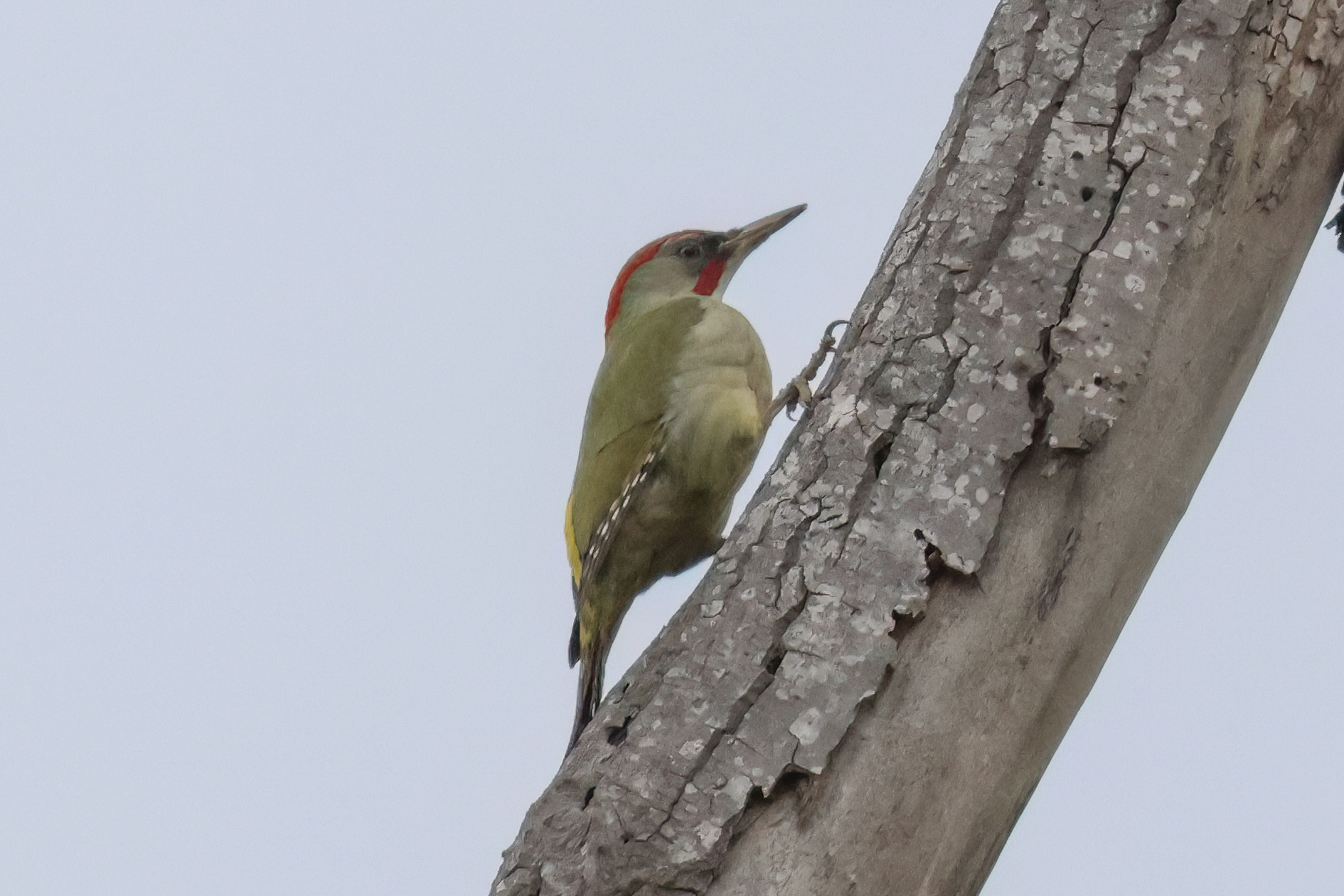
Moving on, we headed up into the Pyrenees, with a quick coffee stop at a filling station on the way where we ate our sandwiches and a couple of the group tried some of the local pastries. Our destination was Coll de Pal, and as we drove out of Barcelona we were pleased to see a good covering of snow on the higher peaks. It was mid afternoon before we got there and as we drove slowly up towards the top, we scanned the sides of the road and any bare patches of vegetation which were not hidden by snow. Stopping to scan a likely looking slope, we noticed an Alpine Accentor feeding quietly just above the verge and when it flew higher up, a Snowfinch flew across too. We quickly pulled over and got out, training the scopes on the Snowfinch first.
We realised now that there were actually several Snowfinches, at least five, feeding on the grassy patches on the slope. We had some great views of them. Particularly at this time of year, it is very easy to miss them as with a warming climate they have often moved back higher by now and with temperatures in the 20Cs earlier in the week they had apparently not been here. Fortunately for us, there had been a significant fresh fall of snow in the last couple of days which had pushed them back down again. The Alpine Accentor slightly played second fiddle, but we did then turn the scopes onto that for a closer look. As they all moved higher up the slope away from us, we decided to try our luck on the other side of the pass.
The snow was even thicker the other side and did not look particularly suitable. We had a quick scan but couldn’t see any signs of life so decided to go back to see if the Snowfinches had moved back down towards the road. Sure enough, they had – two were on the bank above verge initially, but moved quickly back up away from us again. Having had great views of them, we decided to move on. A little further along we found another Snowfinch right beside the road, but as we pulled up for a photo shoot some snow moving machinery came up the road the other way and spooked it. Typical timing!
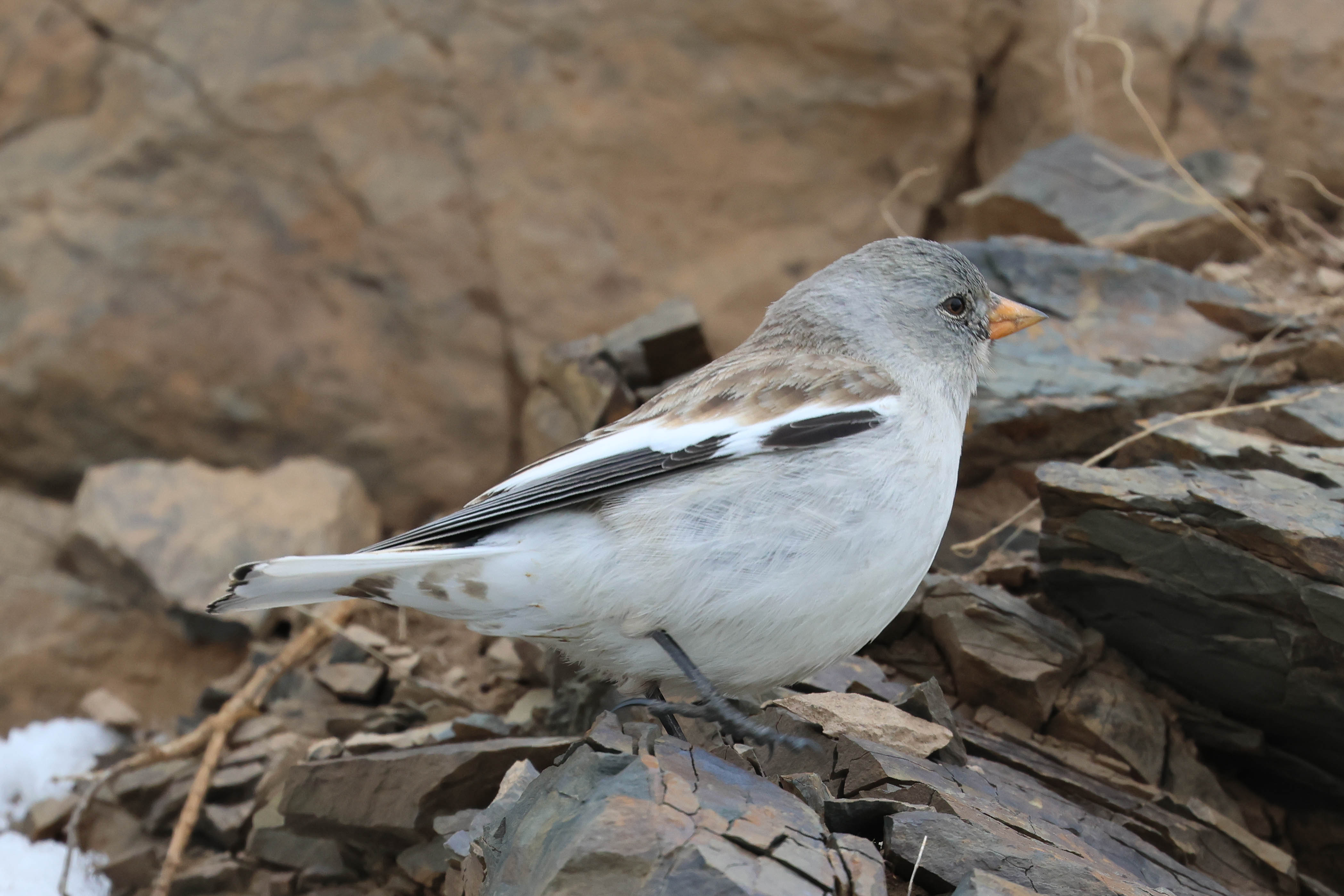
We drove over to Masella next. We were hoping to look for Citril Finch here, but as we got up towards the ski resort it quickly became clear there was lots of thick lying snow here too. Not great for finches! We pulled over and had a short walk – at first it seemed rather quiet, just a Crested Tit called from the pines. But first we heard some tapping and then Carles noticed a Black Woodpecker’s head peeking out of its hole in a distant tree. We walked further up and trained the scopes on it. Eventually it flew out and up into the pines further back, calling. It was decidedly cold here and starting to snow very lightly, so we headed back to the minibus and drove back down.
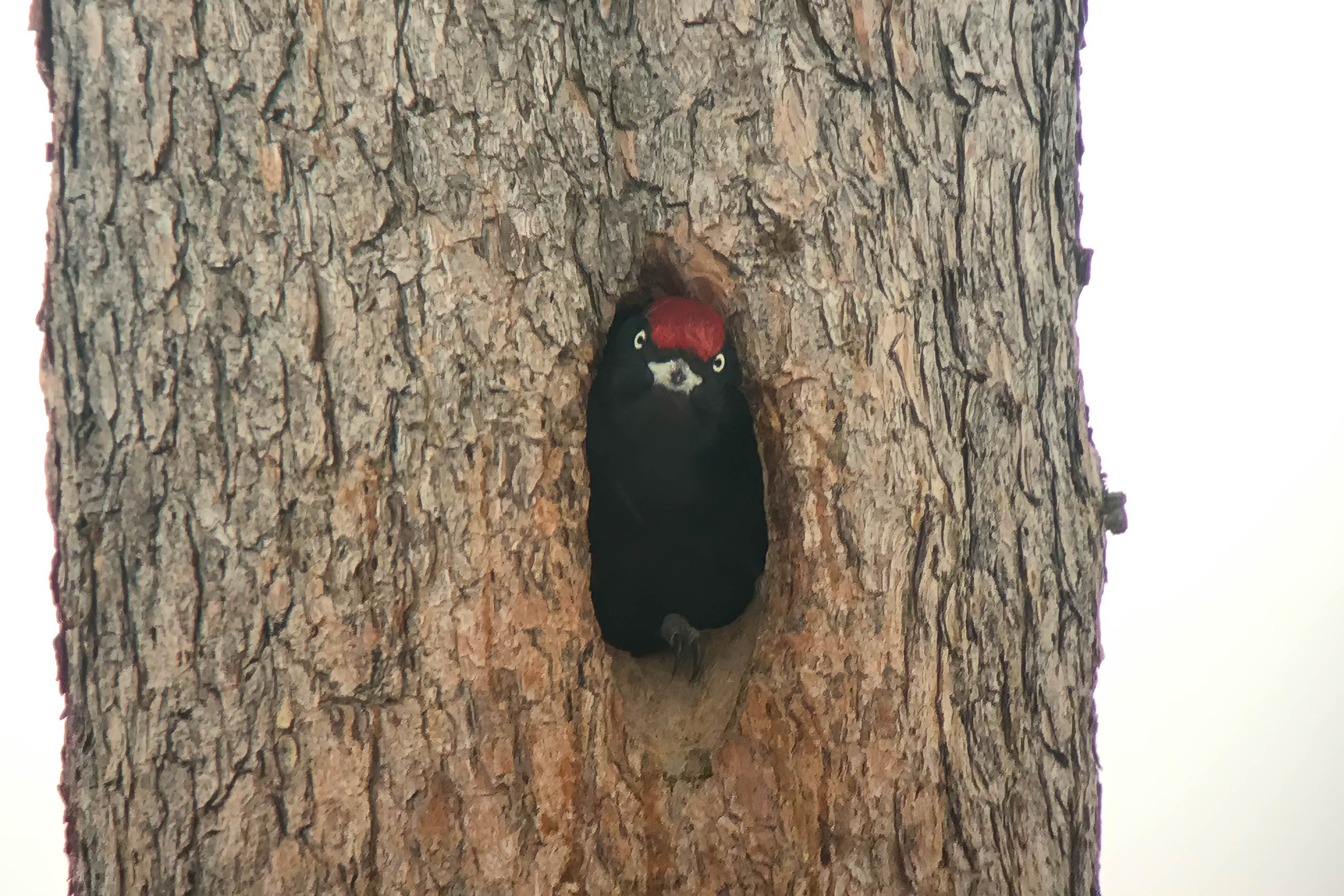
We were initially planning to call it a night, but on our way to the accommodation we saw several small finch flocks come out of the fields and a flock of Fieldfares fly over the road. We decided to check a scrubby hillside behind the next village. As we pulled up amongst the houses, a Rock Bunting appeared in a small bare tree in the parking area and then a second, a smart male Rock Bunting perched up in the top of a nearby fir. We walked a short way along the track which led up the hillside beyond. A Woodlark was perched on the wires and at least six Rock Sparrows were too, over towards the edge of the village.
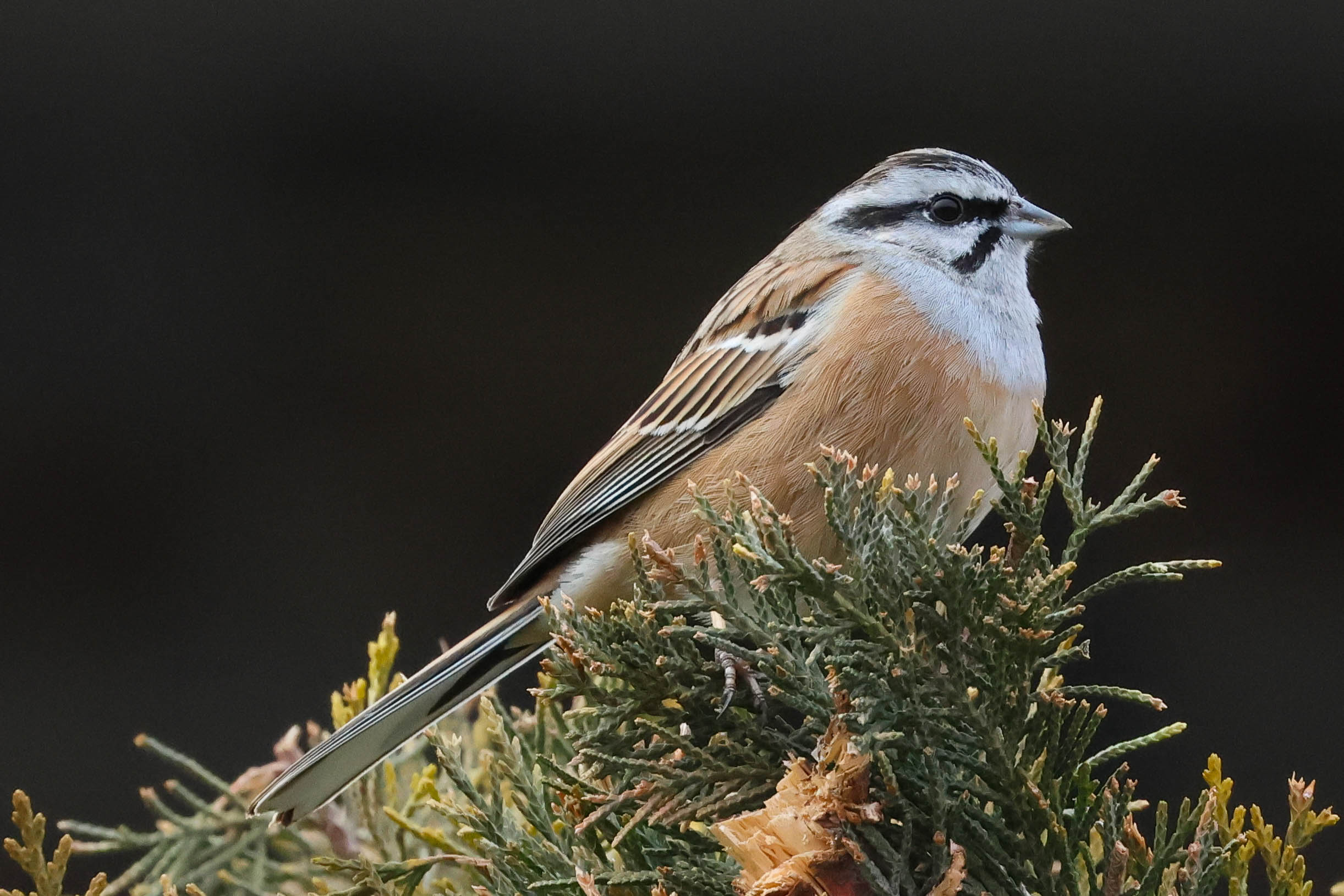
The light was starting to go now, so we walked back down to the minibus and made our way over to Olopte, where we would spend the night. After a break to check in and freshen up, we headed out to a local restaurant for a delicious meal of typical Catalan food. It had been a very long day, so most of the group headed for bed now, but for those who could stay up a little longer the resident Beech Marten eventually put in an appearance at the feeding station outside.
SUNDAY 26TH FEBRUARY
After breakfast, we packed up the minibus again. A Black Woodpecker was calling from the trees nearby and flew past overhead, and we could hear Iberian Green Woodpecker too. A flock of Siskins landed briefly in the trees. Thankfully there hadn’t been the forecast huge snowfall overnight but there was a dusting of snow covering the fields as we headed higher to check an area where there had been Citril Finches in the last few days. There were lots of finches here, but they were mostly Chaffinches, plus a decent flock of Greenfinches and another small group of Siskins briefly. There were a couple of Mistle Thrushes perched on the bushes, plus a large flock of Fieldfares and two Redwings with them. A smart male Rock Bunting perched on the edge of the trees in front of us.
Looking over the mountain tops, a large bird was flying towards us, a Lammergeier, our first of the trip. A smart adult, it stopped to circle above us, giving us some lovely views when we could even see its beard, before drifting off in front of the snow-capped peaks to our left. A short while later, what we thought was the same Lammergeier came back and circled overhead once more, but checking photos later it appeared to be a different individual and this one was carrying a bone in its talons. A Kestrel perched in the top of a small bare tree just below the road as we walked a short distance, and two Iberian Green Woodpeckers called and flew off down the valley. We drove a little higher but the snow was even thicker here and there were few birds, just a Stonechat.
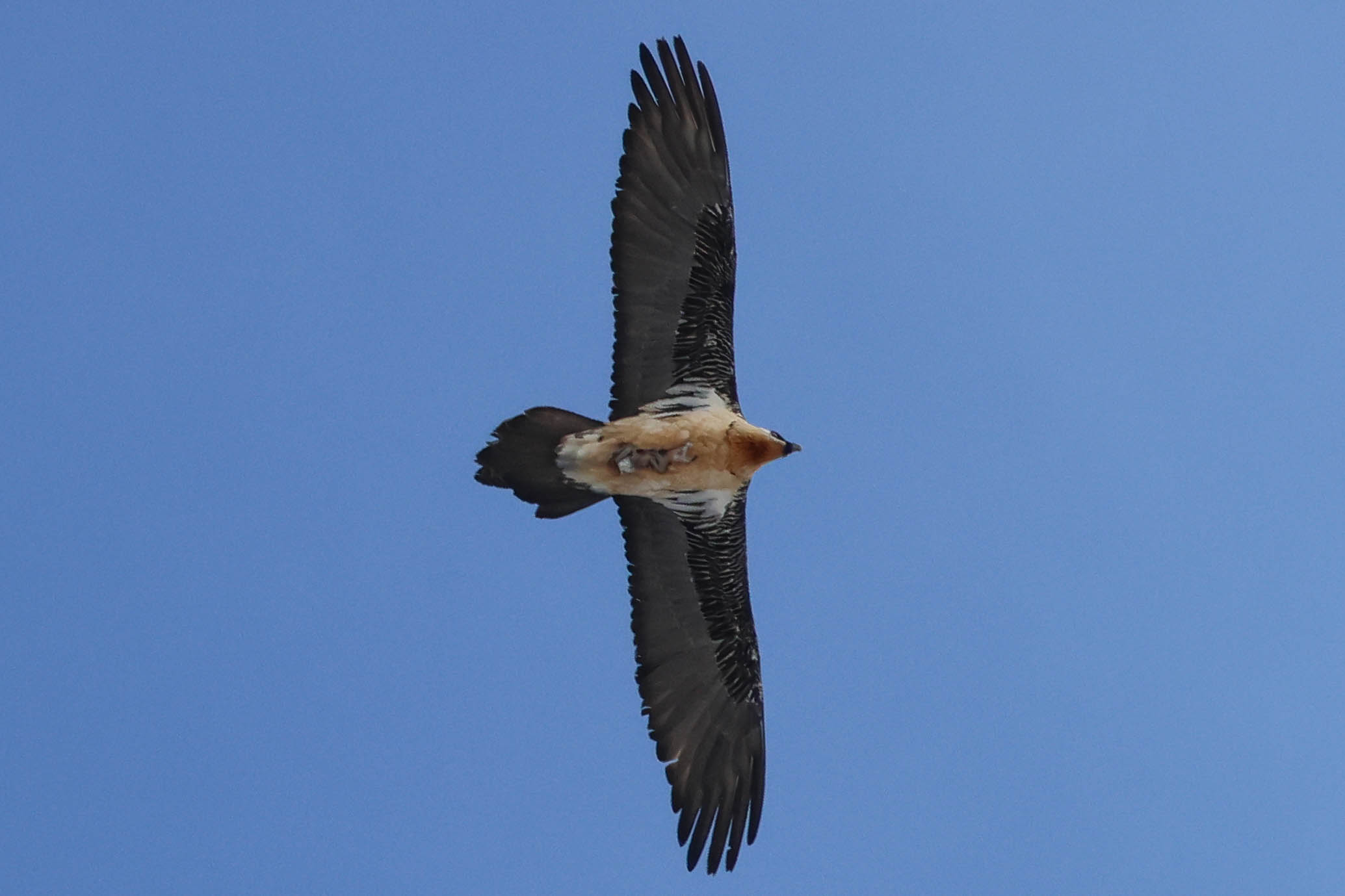
We decided to try lower down, where there was no snow. A quick check of the hillside below Olopte produced a singing Woodlark but no finches, so we went back to have another look at the hillside we had tried briefly last night. As we got out of the minibus, there were several Tree Sparrows with the House Sparrows in the trees in the village. At least nine Rock Buntings were feeding on the short mown grass of a tiny municipal park between the houses, along with several Black Redstarts too. A Robin flew up onto the belltower of the church beyond.
As we walked up the hillside, several Woodlarks were singing in the sunshine and a Skylark called as it flew over. A pair of Iberian Grey Shrike perched on top of the bushes on the edge of the field below us, where a small mixed flock of buntings were feeding. There were several Cirl Buntings and Rock Buntings and a single rather drab female Yellowhammer, but there were few finches feeding in the fields here. A Lammergeier appeared over the top of the hill a couple of times and two Griffon Vultures drifted over high in the distance. As we walked back, a Crested Tit called and showed briefly in the top of a small pine tree.
A stop to use the facilities at a nearby filing station produced Coal Tits and Blue Tits and we heard a Short-toed Treecreeper calling. Then we headed back up to the hillside above Olopte for another quick look there. The overnight snow had melted rapidly in the sunshine, but all the finches and thrushes had disappeared now and there was still no sign of the hoped for Citril Finches – they had possibly moved down lower again due to the recent wintry weather. We did have a different Lammergeier here now, this time an immature, and a pair of Golden Eagles high over the hill tops.
We had a long drive this afternoon, down out of the Pyrenees and across to Aragon. As we came down through the mountains, we could see lots of cloud gathered in the pass below, so we stopped for lunch at a picnic stop in the last of the sunshine. A small flock of Long-tailed Tits were feeding in the trees between the road and the river below and a Chiffchaff and Blackcap were with them. A Grey Wagtail called from the river below, along with a couple of Wrens. As we came out onto the plains below, thankfully the sun was out although the wind had picked up.
We broke the journey again near Lleida, where a Long-legged Buzzard has been spending the winter. As we pulled up, an impressive number of Common Buzzards and Red Kites were hanging in the air over the low ridge in front of us. A Goshawk shot past low over the fields and a Marsh Harrier hung in the air over some reeds further down. A pair of Serins were perched in a nearby bush as we got out, Linnets and a few Corn Buntings were in the fields and Crested Larks were calling all around us. We didn’t have to wait very long before the Long-legged Buzzard appeared. It circled up with three Common Buzzards, giving us a good chance to compare them, the Long-legged Buzzard noticeably bigger, longer-winged and paler. They drifted gradually closer, before the Long-legged Buzzard and one of the others broke off into a long glide and disappeared over the low hillside off to our right.
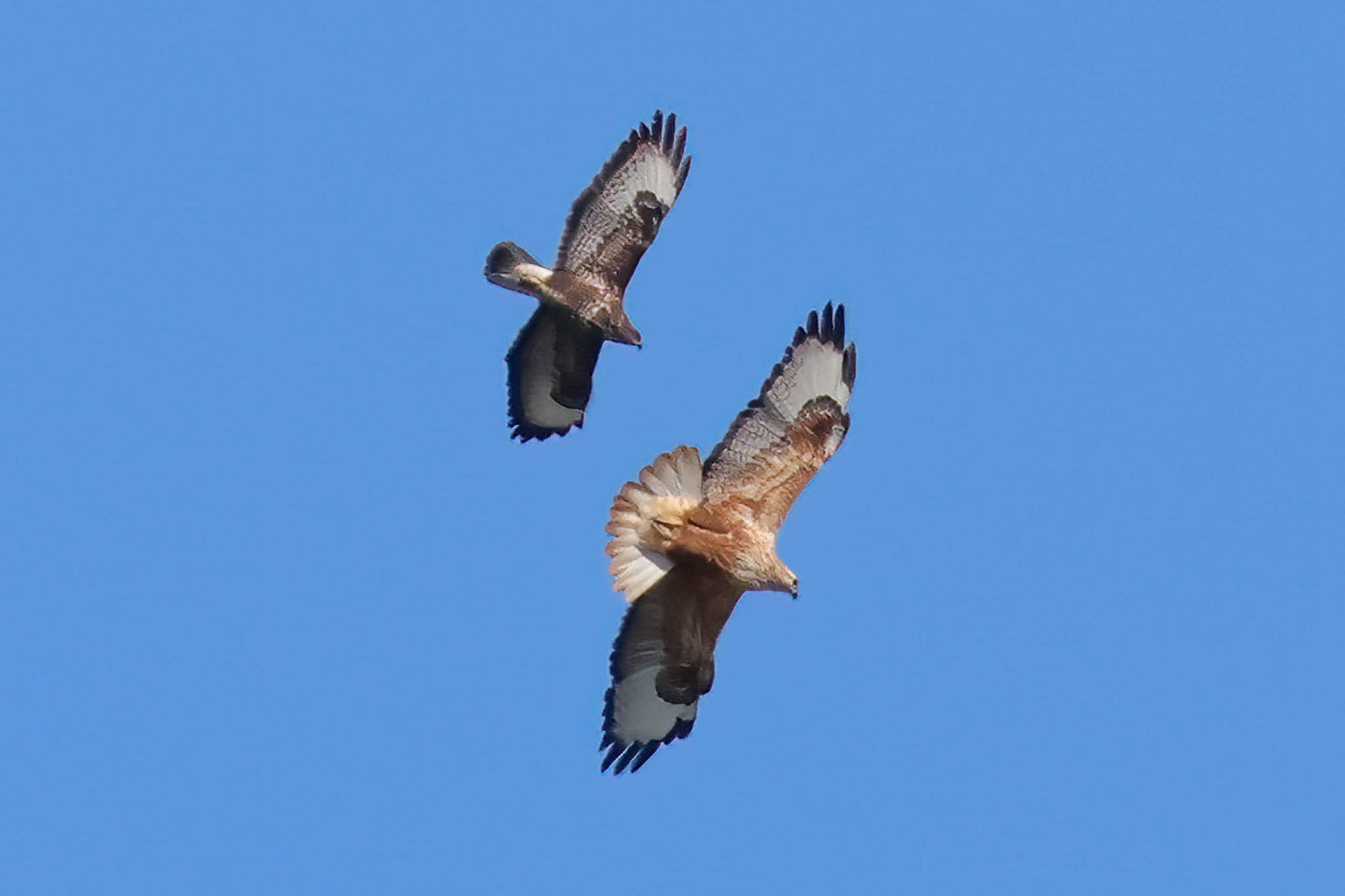
As we didn’t want to be too late getting there, we headed straight over to our final stop of the afternoon now at Santa Ana. En route, we saw another Goshawk by the road and beyond Balaguer we started to see our first Spotless Starlings. We parked at the start of the gorge and walked slowly up towards the dam, scanning the rock faces. It was rather quiet here at first, apart from several Crag Martins around the cliffs. An Iberian Green Woodpecker shot past along the cliff above us and then two large raptors drifted high overhead. We were hoping to see Bonelli’s Eagle here but as we looked up we realised that while one was indeed a Bonelli’s Eagle it was following a Golden Eagle, the two of them circling and tousling briefly in the sky above us. A squadron of three Griffon Vultures came high over the tops the other side of the gorge.
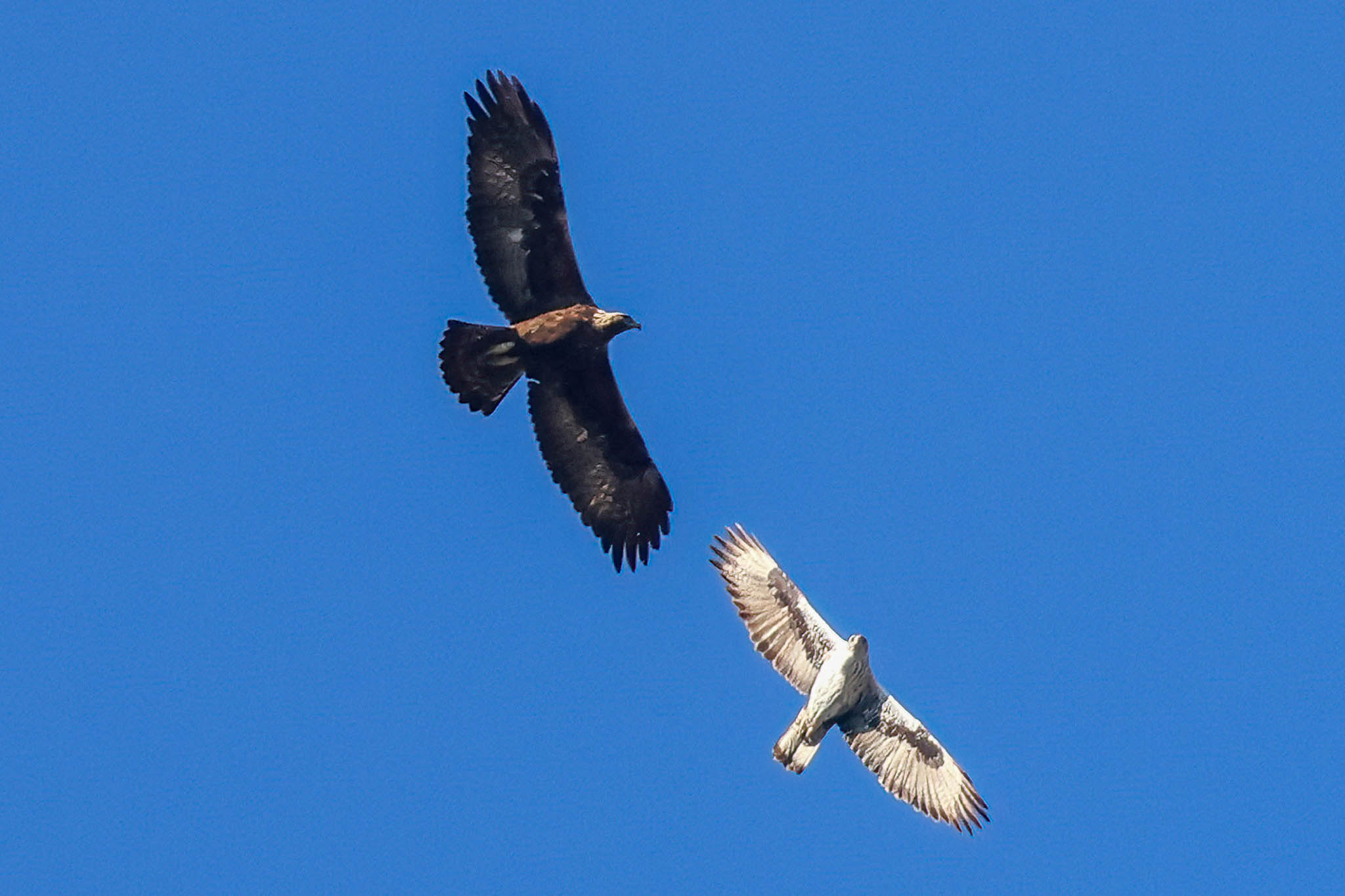
Continuing on over the bridge, Carles spotted a Wallcreeper on the large rock outcrop opposite. We quickly got it in the scopes and watched it scaling the face, flicking its wings and flashing the deep red as it did so. After a short while it took off and we realised it was flying over the gorge to our side. It landed high on the crag above us, in the sunshine now, where we had an even better view as it continued its ascent, before eventually disappearing round behind the top of the rocks. A stunning bird and a much wanted lifer for many of the group.
We walked on through the next two tunnels towards the dam, scanning the cliffs, but could not relocate the Wallcreeper the other side. There were several House Martins with the Crag Martins here now. A Chiffchaff was flycatching from the bushes and a Firecrest showed really well just beyond the last tunnel. A couple of Cetti’s Warblers shouted from down by the river in the bottom of the gorge.
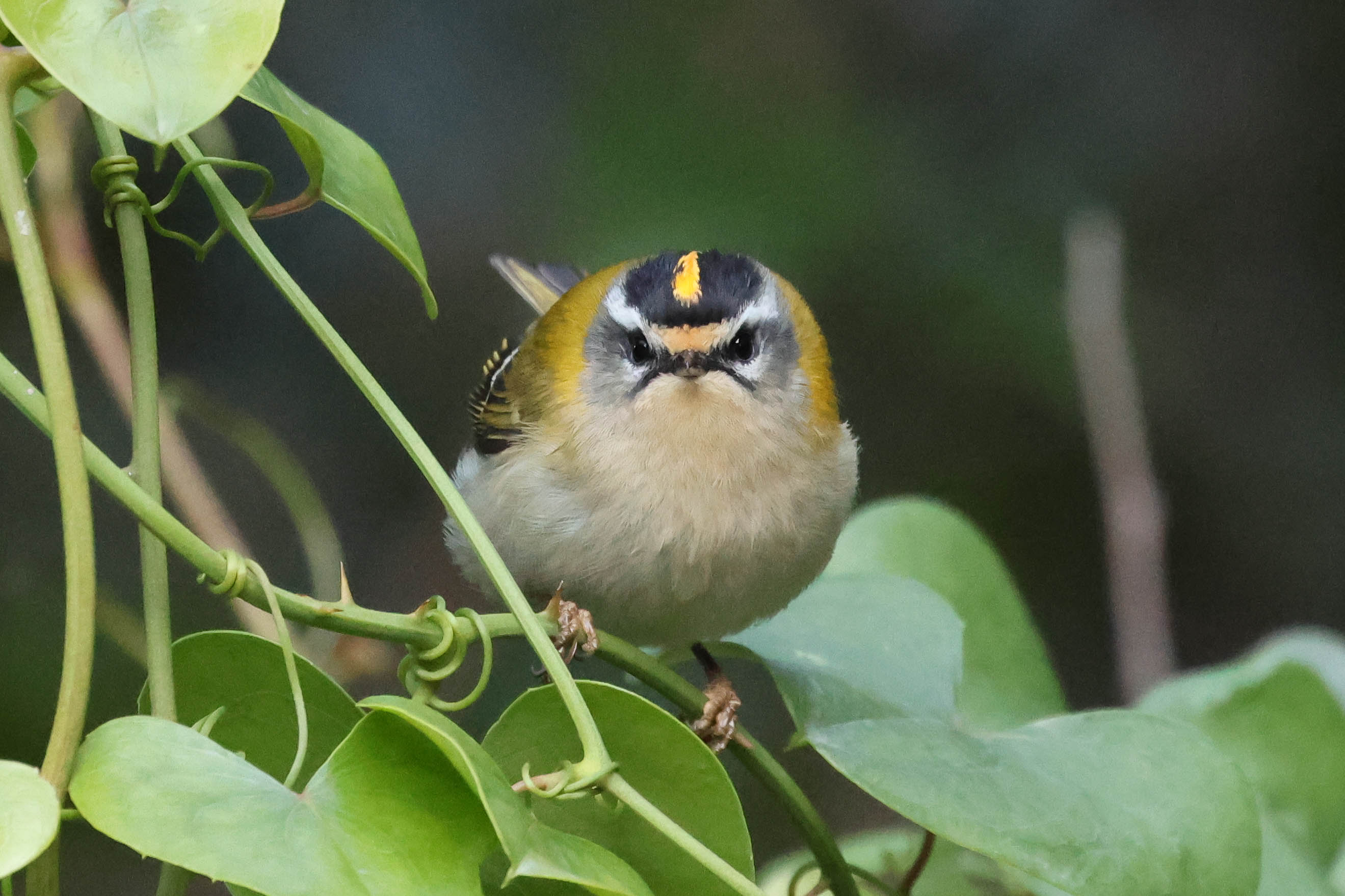
The light was starting to go now, so we walked back to the minibus. As we got back towards where we had parked, a Griffon Vulture dropped off the cliff above and flew off away from us. A couple of seconds later, it came back and as it did so we noticed another Wallcreeper fly off the rocks high above the minibus. It disappeared round the corner away from us, so we walked a little further down to see if we could relocate it but there was no further sign. Three Rock Sparrows flew in high over the gorge.
It was another hour’s drive from here to our base for the next few nights at Arbanies. Another Goshawk flew over the road ahead of us, our third of the afternoon. There were more White Storks now in the fields and lots of their nests on nearby towers. A large group of Cattle Egrets was just going to roost in some trees. It was dark by the time we arrived. After settling in, we just had time for a beer and to run through the day’s list before delicious home cooked dinner of creamy vegetable soup and slow-cooked chicken served in a huge cast iron cooking pot.
MONDAY 27TH FEBRUARY
It was a lovely bright, sunny start to the day, if a bit cold. As we were loading up the minibus after breakfast, there were several Spotless Starlings on the roofs in the village which looked very smart in the sunshine.
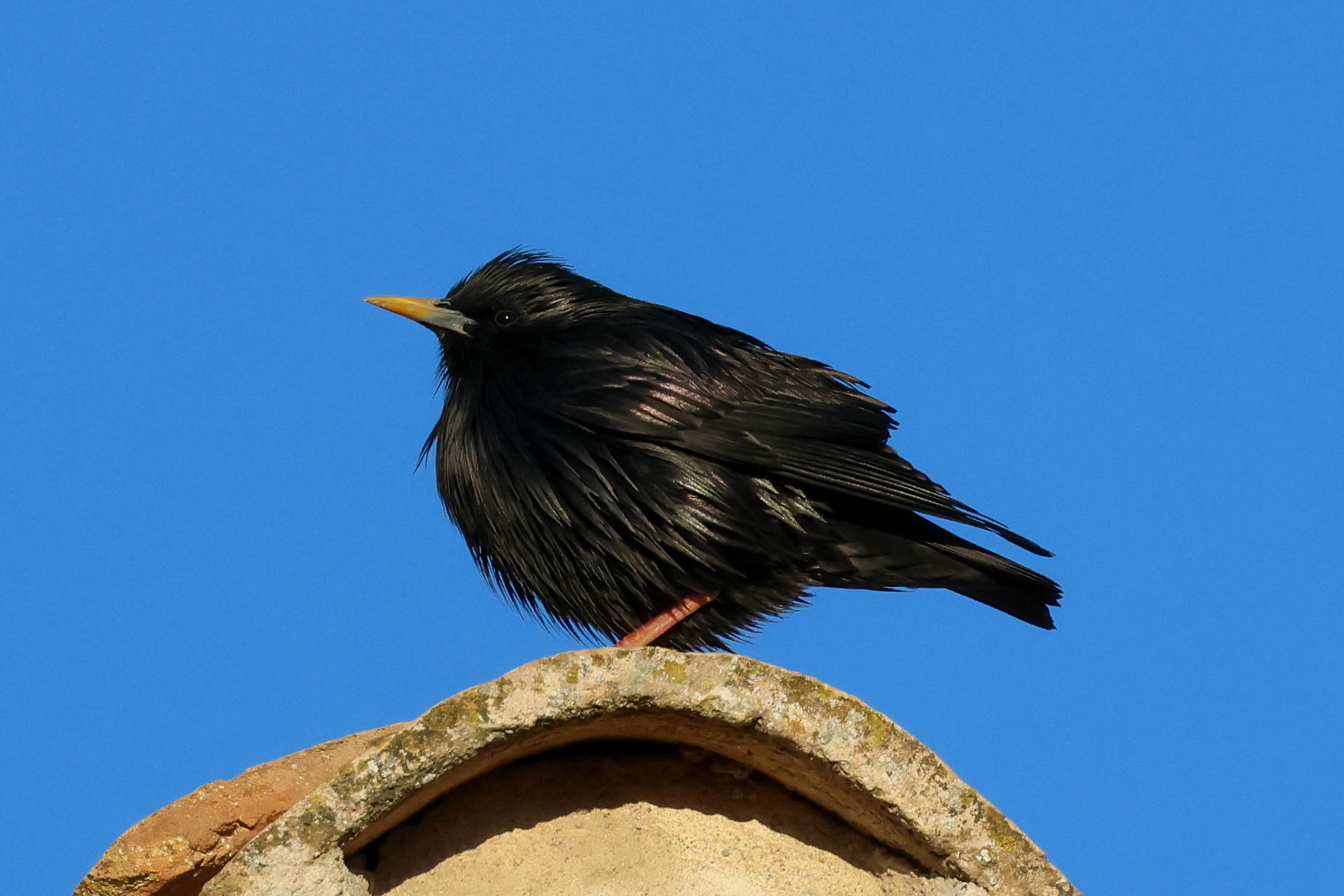
There was a noticeable cold wind blowing by the time we got to Mallos de Riglos. A couple of Fieldfares flew off calling from the bushes as we walked up through the houses. We were hoping for closer views of Wallcreeper this morning, so we walked up to the base of the cliffs and scanned the rock face. Carles had a brief glimpse of one, deep in a crevice, but it disappeared immediately before anyone else could get the right angle to see where it had been. A male Blue Rock Thrush perched nicely in the sunshine, about half way up, then flew round the face. Griffon Vultures cruised back and forth round the rock towers overhead.
It took a while before the Wallcreeper reappeared, some way up the rocks and a little further round from where it had been. We watched it feeding for some time above us, climbing nimbly around the sheer face and occasionally flying a short distance on its broad, rounded butterfly-like wings, showing off the white spots in its primaries from below. It gradually worked its way lower down, so at one point it wasn’t too far up, certainly closer views than yesterday, before it climbed back up again. It felt like that might be the best of it, but then it flew round past us, and seemed to be dropping. We scrambled round over the steep gravelly paths through the bushes and as we rounded the corner, there it was about eye level on the face in front of us. It gradually worked its way back up a little higher and continued round the cliffs. At one point, the male Blue Rock Thrush flew down and swooped at it a couple of times. We were just starting to try to descend down over the loose rocks when the Wallcreeper flew down again behind us and landed just a few metres away, right at the base of the cliffs. Unbelievable now, right in front of us. Wow!
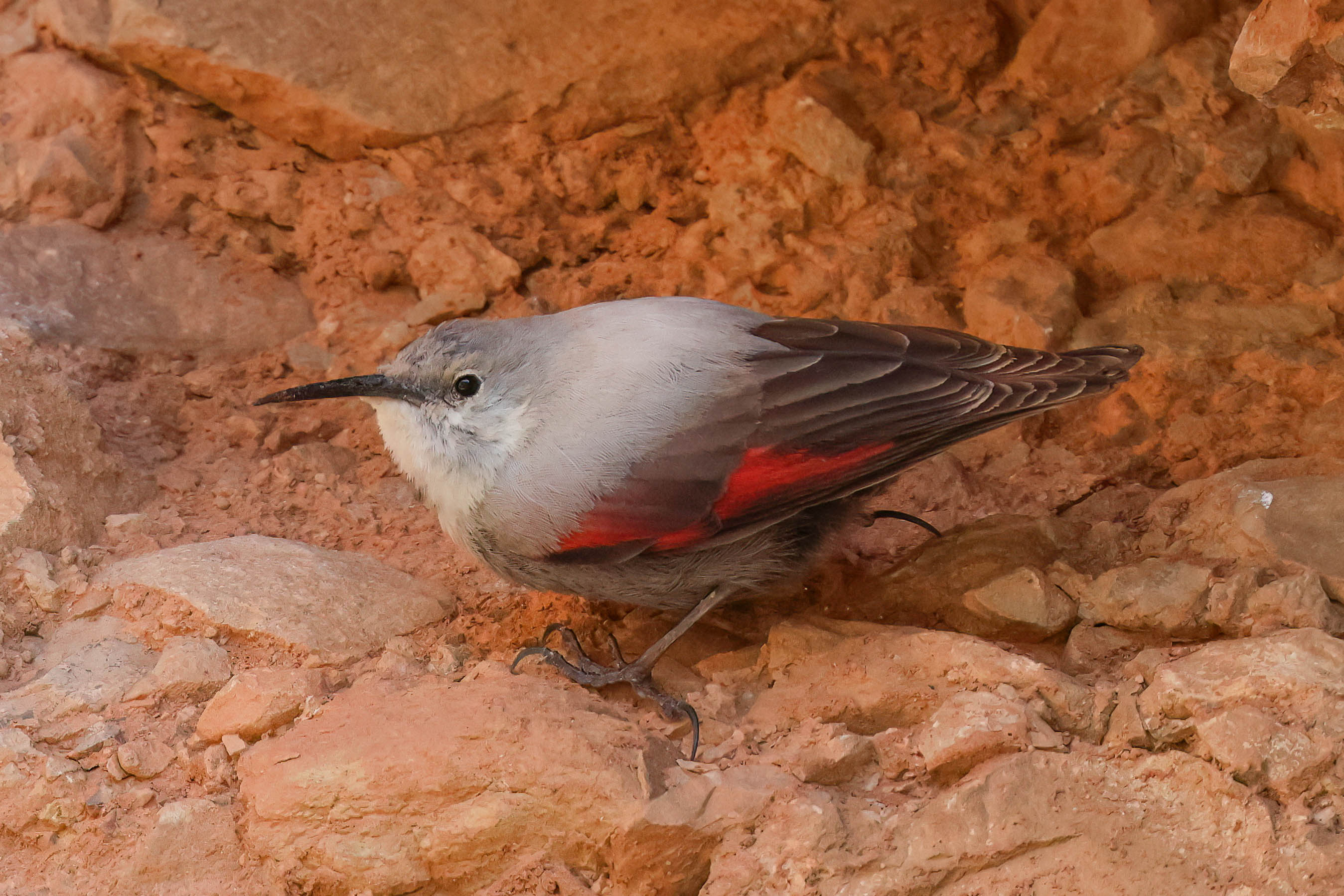
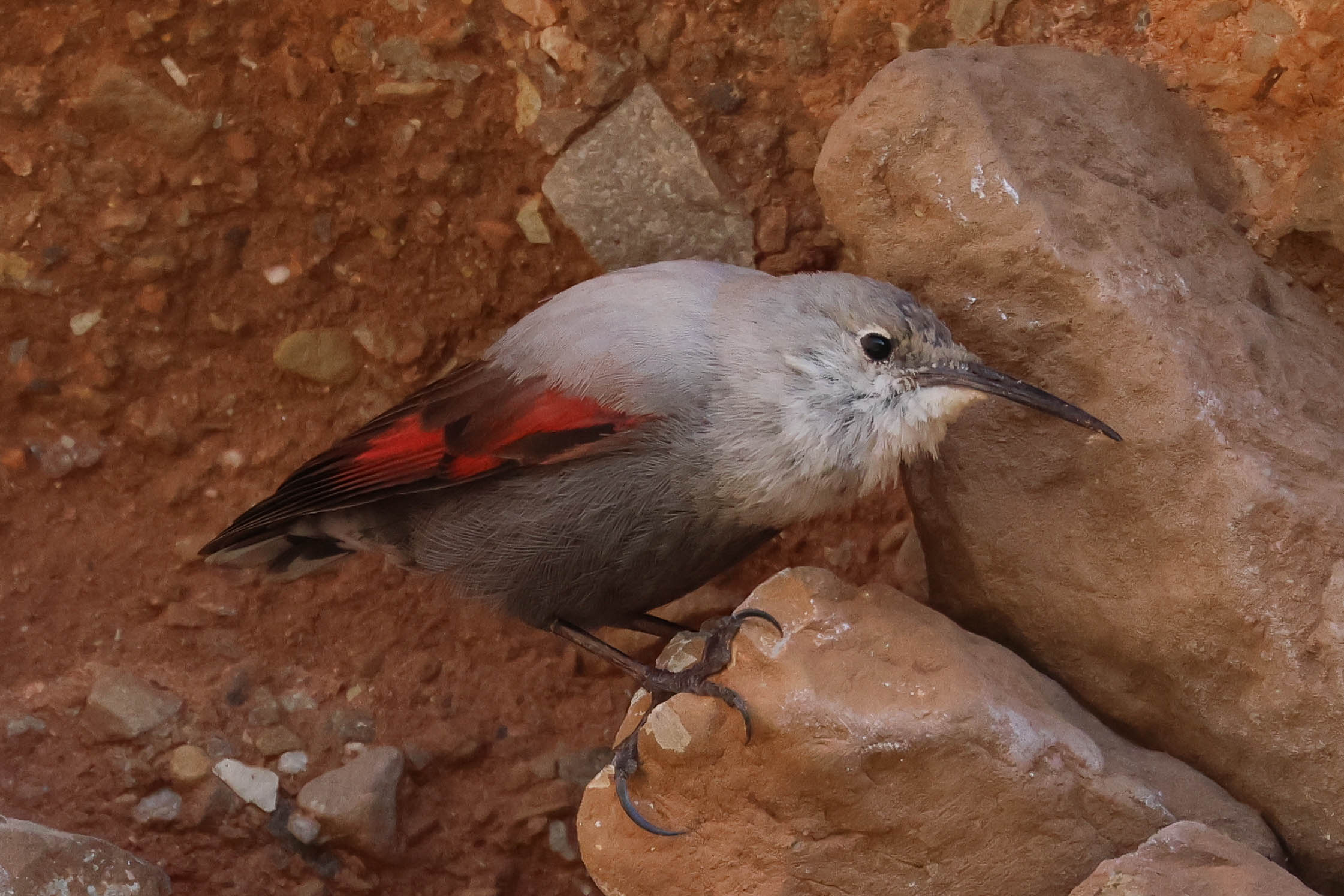

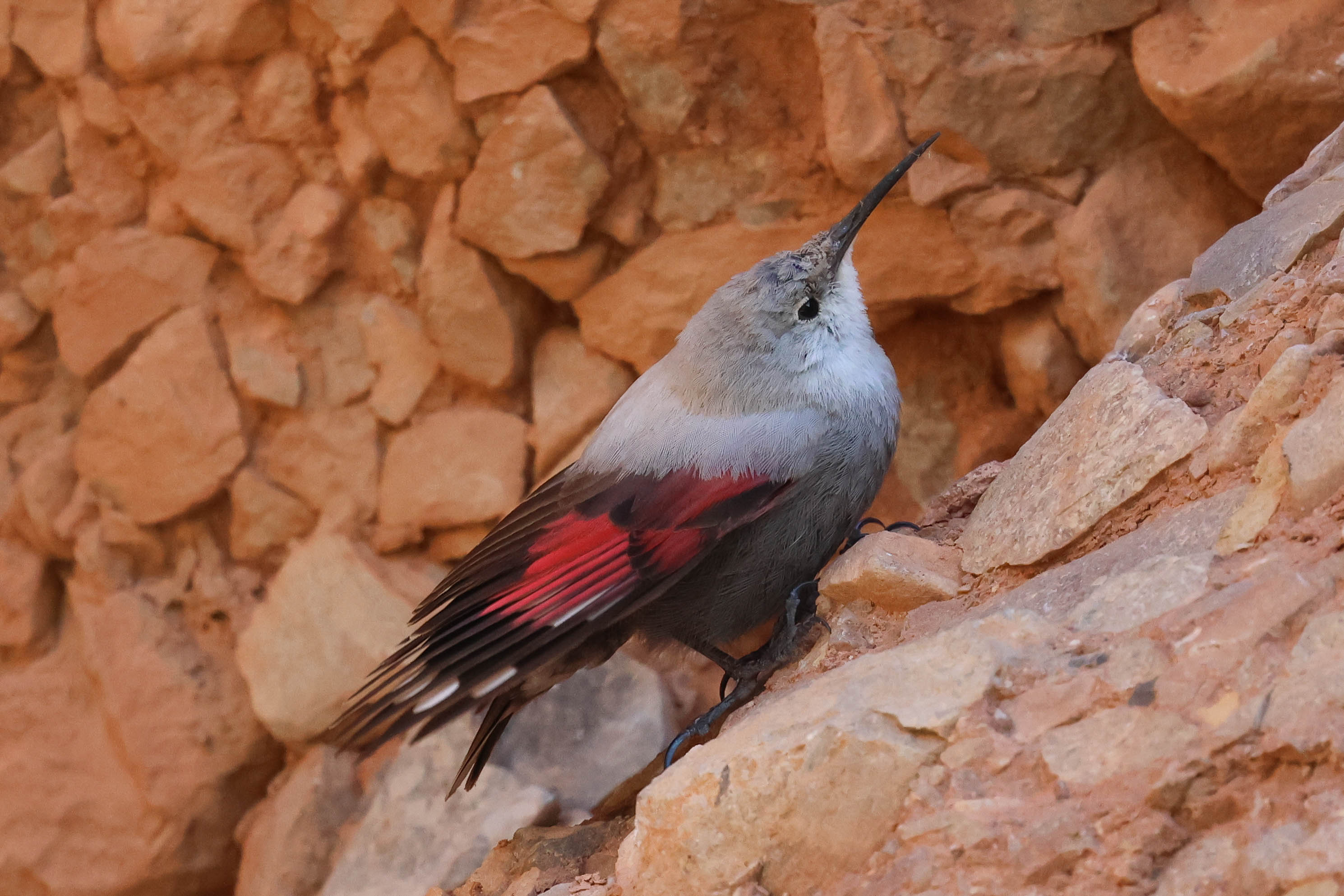

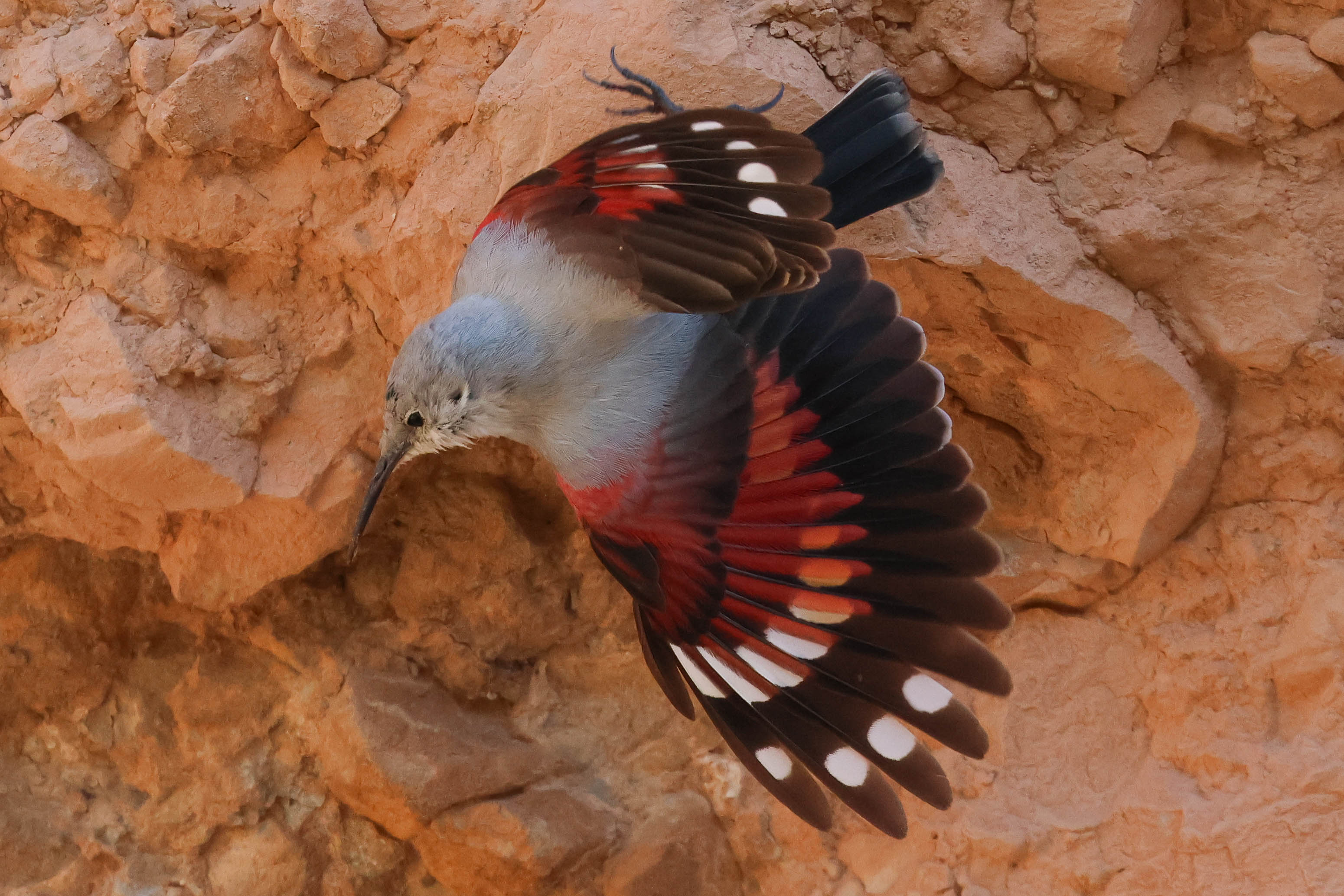
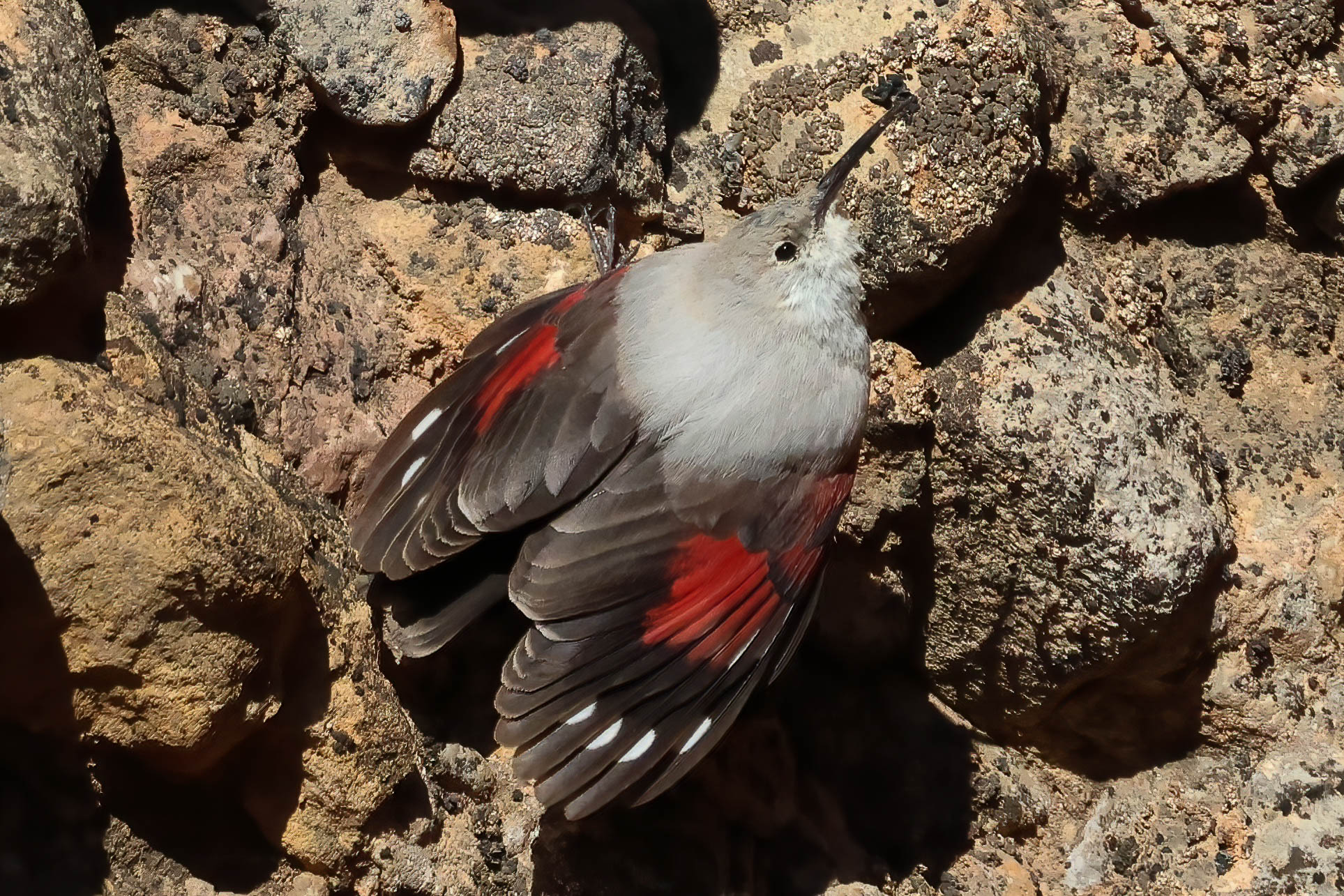
Eventually the Wallcreeper moved up again and further round the face where it was harder for us to follow. We simply couldn’t hope for better views anyway, so we made our way carefully back down. There were several birds feeding in a sheltered vegetation plot in between the houses in the village so we stopped to look. A Dunnock was hopping around between the onions and a female Blackcap was feeding in the ivy at the back. There were Robin and Song Thrush too, and a couple of Serins dropped in. Then it was time for a well-earned coffee break at a nearby café.
It was already time for lunch when we got to the base of the hill below Montearagon, but we were distracted initially by a Dartford Warbler in the short scrub in front of us and a distant pair of Black Wheatears higher up on the rocks towards the castle. We then watched them while we ate. Afterwards, we drove up towards the top, stopping on the road for better views of the Black Wheatears below us now. A Thekla’s Lark was feeding in the vegetation above the road a little further on, so we walked up a narrow path which cut across the next hairpin and then had great views of it feeding on the side of the tarmac and then singing from the stone plinth by the entrance barrier to the castle. A Blue Rock Thrush flew across behind us and landed briefly on the crash barrier and a couple of Crag Martins flew round overhead. We stopped here to admire the view, looking over towards the Pyrenean foothills.
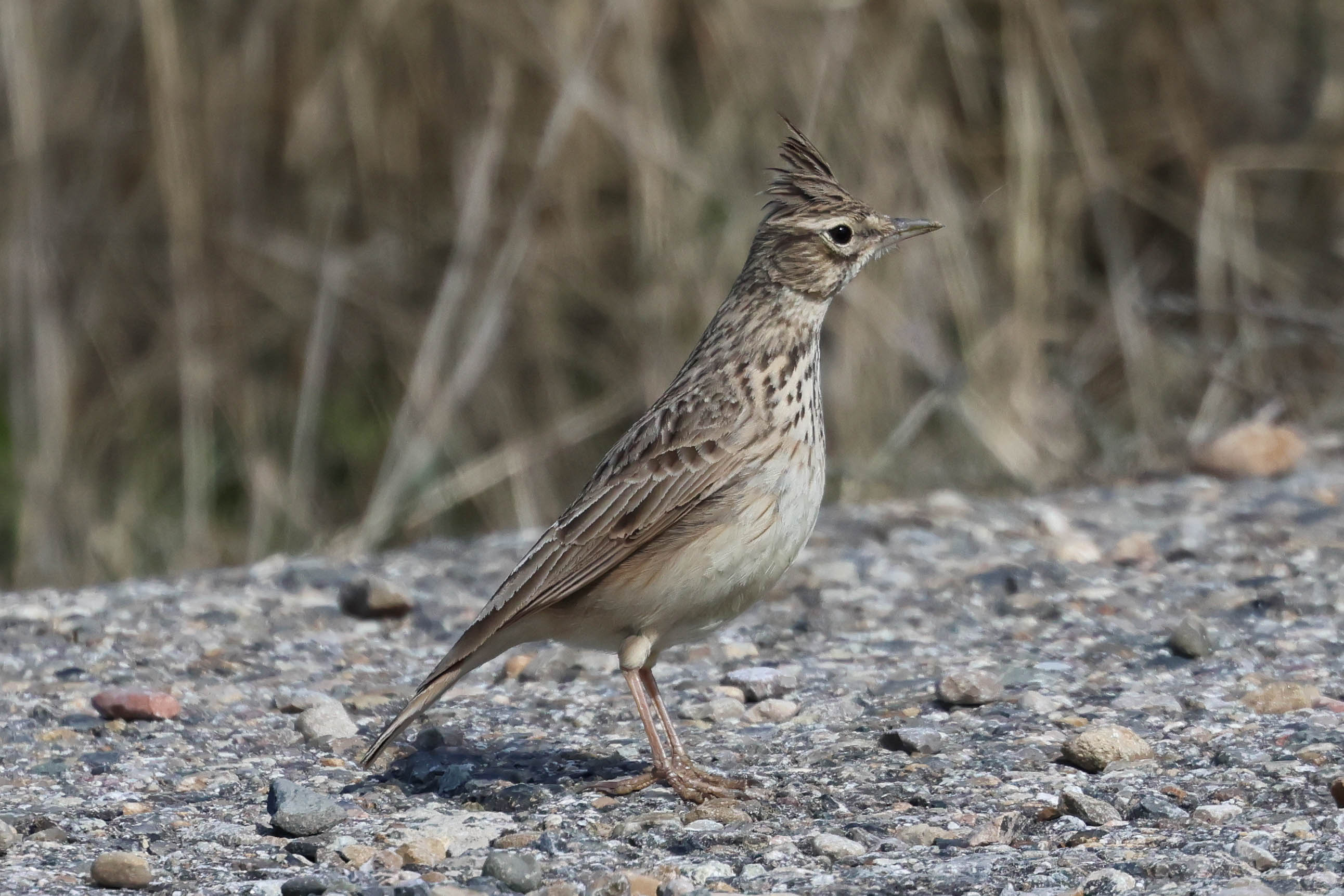
We had time for an extra stop at a nearby small wetland now. As we got out of the minibus there was a cutting chill to the fresh wind. Lots of hirundines were hawking low over the water, mainly Crag Martins but a couple of House Martins and Barn Swallows and a single Sand Martin were feeding in with them and we eventually found a lone Red-rumped Swallow too. There were Chiffchaffs everywhere, in the reeds, along the concrete dam and in the trees around, and quite a few Robins too. Several White Wagtails and Water Pipits were feeding around the reeds and on the short grass along the near shore in front of us. There was a nice selection of ducks to bolster the trip list: Shoveler, Teal, a couple of Wigeon and a drake Gadwall, plus several Little Grebes, Coot and Moorhen. We thought we might find some sandpipers around the water’s edge, but scanning carefully the best we could do was a single Common Snipe right over the far side.
Our final destination for the afternoon was the Embalse de Sotoñera. As we drove out from the village, two Little Owls were staring at us angrily from a pile of rocks. Further down, there were three Common Cranes in a nearby field, a small foretaste of what was to come, and a male Merlin shot past.
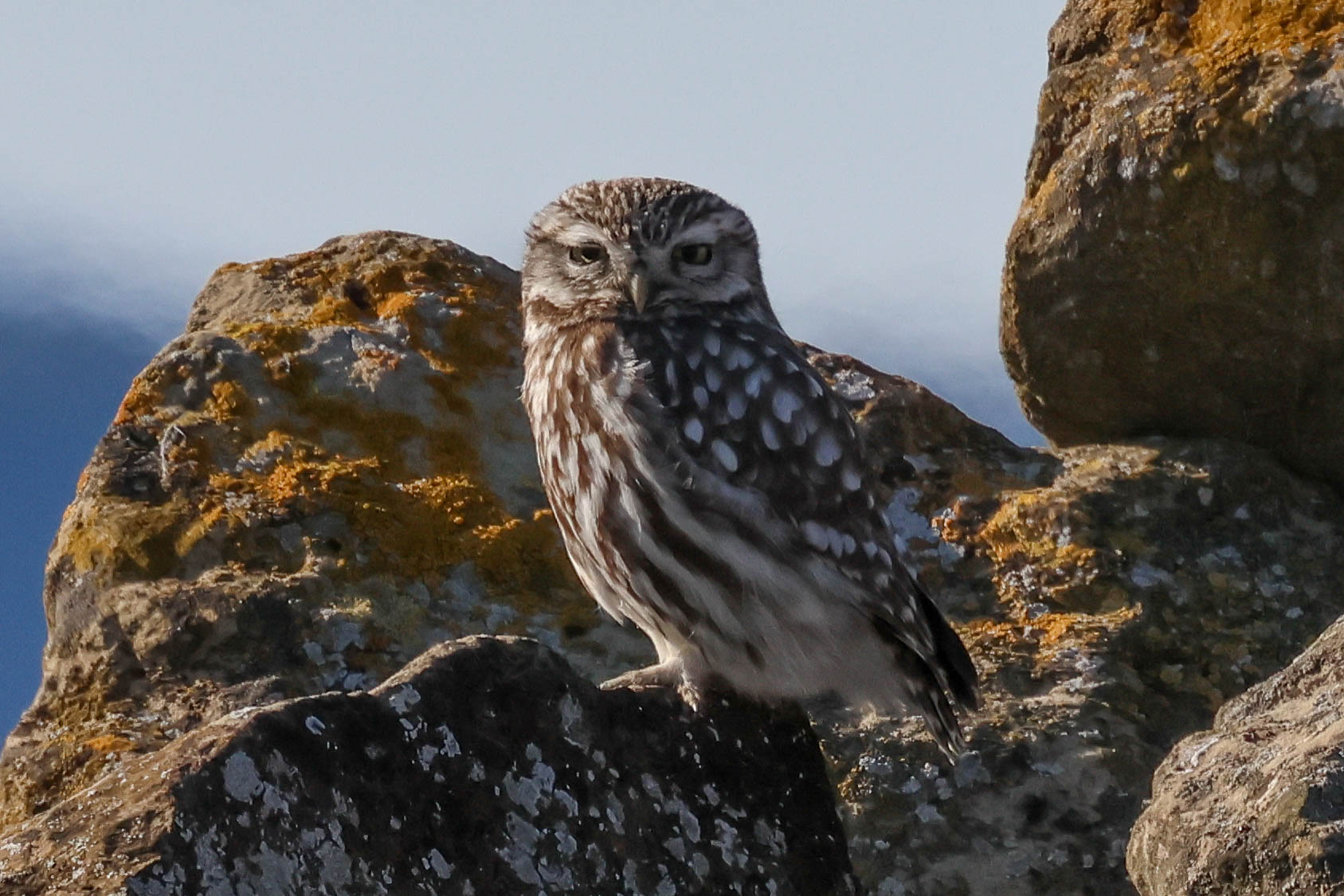
As we got out of the minibus, two shepherd’s dogs came running over from the nearby flock of sheep to investigate, but seemed friendly. A Goshawk flew low and fast across the grass in front of us and a young Golden Eagle circled in the distance, mobbed by a couple of Yellow-legged Gulls. One or two Great Crested Grebes were just visible far out on the water. There were lots more Cranes here, several hundred at least, though mostly out of view in the field behind the bushes which fringed the lake. A couple of times, a large group flew up bugling loudly and dropped down again further back.
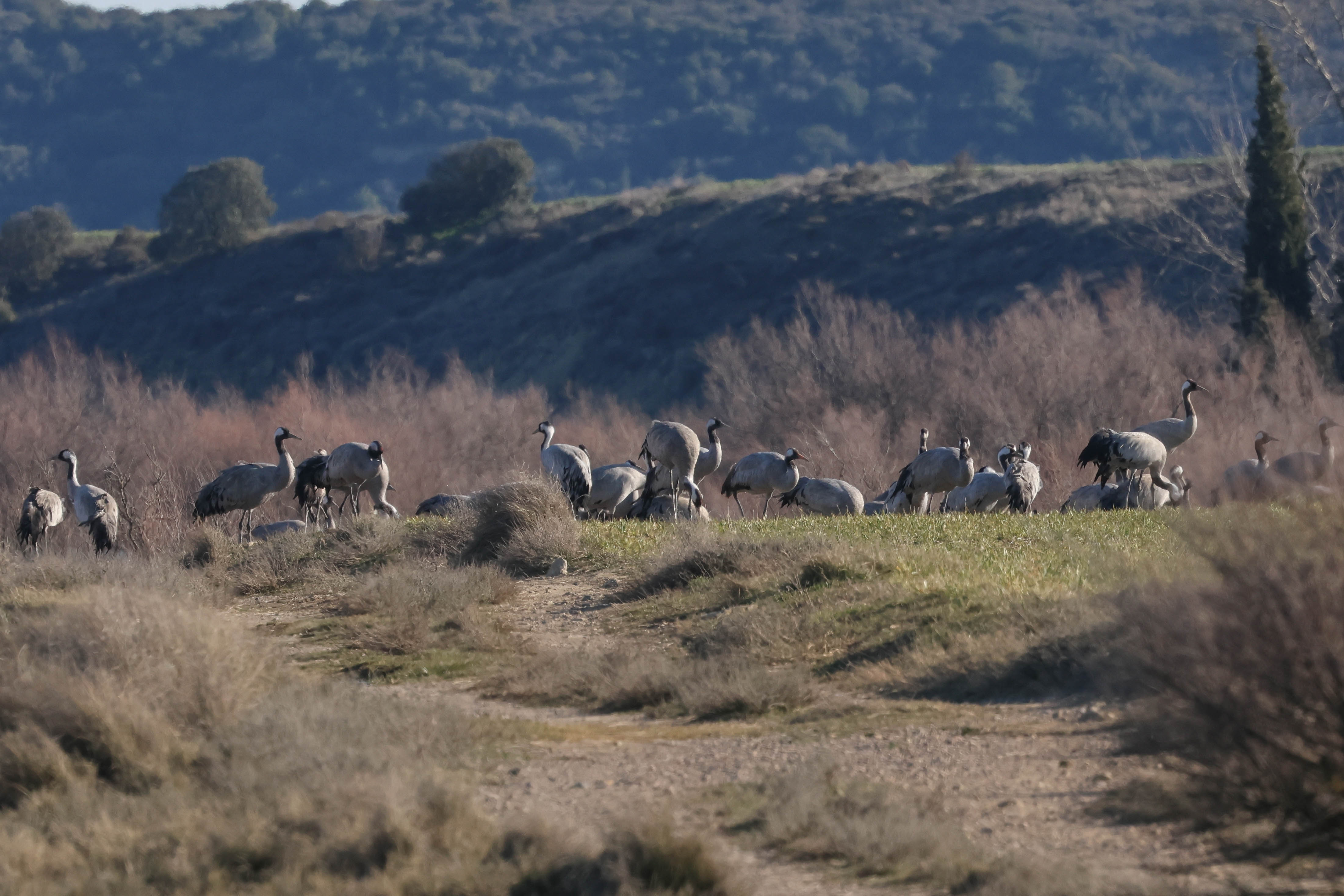
We walked a short way round the edge of the reservoir, where there were lots of Crested Larks and Corn Buntings feeding on the short grass and a surprise early Northern Wheatear was with them. There were a couple of pipits with the White Wagtails on the water’s edge, a Meadow Pipit, a conventional Water Pipit and a strikingly darker, dirtier bird which would pass for a littoralis Rock Pipit back at home but which presumably was just an extreme dark Water Pipit here, before it flew off. A Brambling flew over and dropped down into the bushes behind us.
Back in the minibus, we drove a short way round to another arm of the reservoir. As we got out, we could already hear lots of Cranes bugling but we weren’t entirely prepared for the scene when we walked up to the viewpoint on the small hill in front. Down below on the grassy fields around the edge of the reservoir were at least 25,000 Cranes! An amazing spectacle, we stood and admired them for a while, and listened to the sound of them calling.
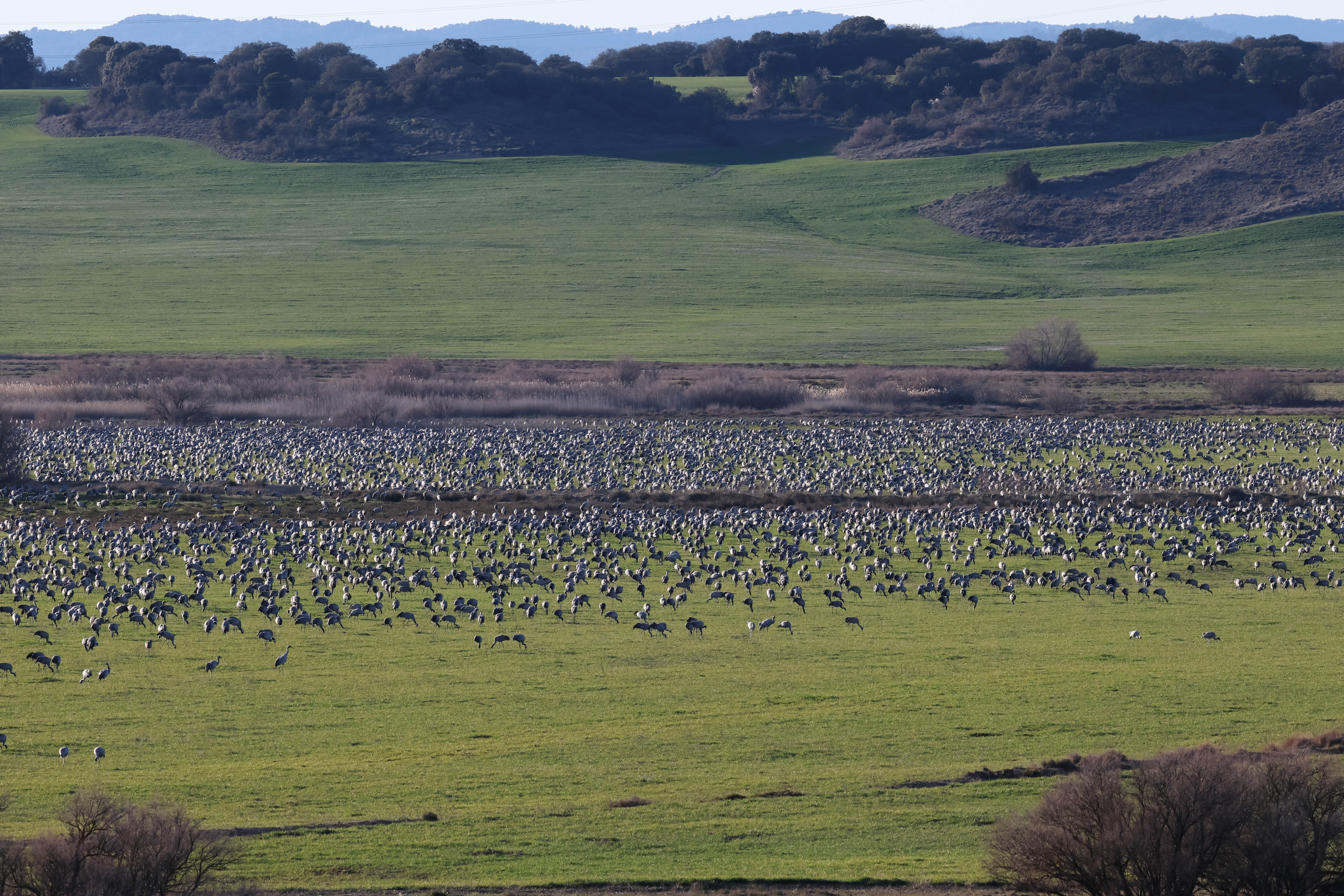
The sun was starting to drop now and it was getting increasingly cold in the nagging breeze, so a fitting end to another brilliant day, we headed back to base.
TUESDAY 28TH FEBRUARY
We were heading up to the high Pyrenees this morning, up to the ski resort at Astun. It was another chilly but bright and sunny start out on the plains. As well as the regular roadside birds on the way, as we got past Jaca we passed a field full of Redwings and Fieldfares and a little further on, a distant large flock of Red-billed Choughs. It got progressively colder as we climbed higher, even without the windchill from the very blustery wind which was funnelling down off the mountains, and as we got past Canfranc we drove into thick cloud and it was snowing lightly.
As we arrived at Astun, the temperature gauge on the minibus was reading -9.5C but thankfully it seemed to be sheltered from the wind here. A couple of Alpine Choughs were huddled on a window ledge on one of the buildings and two or three more were sheltering on the balconies on the other side. We decided to go into a nearby café for a coffee or hot chocolate, and while most of the group were sensibly in the warm, a quick search was conducted around the buildings but there was no sign of any Alpine Accentors here today. After the coffee break, the weather had improved a little, the snow had stopped and it had brightened up a little, so we had walk around. The Alpine Choughs were a little more active now, flying round over the skiers and perching on the buildings and posts around the car park.

With the lower approaches here being so windy, we decided to try over on the French side of the mountains. As we dropped down on the other side of the pass, we could see the differences here, the slopes more forested with beech and firs. We took a small side road and almost immediately our first Lammergeier of the morning was spotted over the ridge alongside. There were lots of birds feeding in the fields lower down here, where there was no snow. We flushed several Jays and a Hawfinch as we passed and there were lots of Mistle Thrushes, Song Thrushes and Robins. Three Alpine Accentors were feeding along the side of the road and as we got out for a closer look, another Lammergeier drifted past along the hillside.
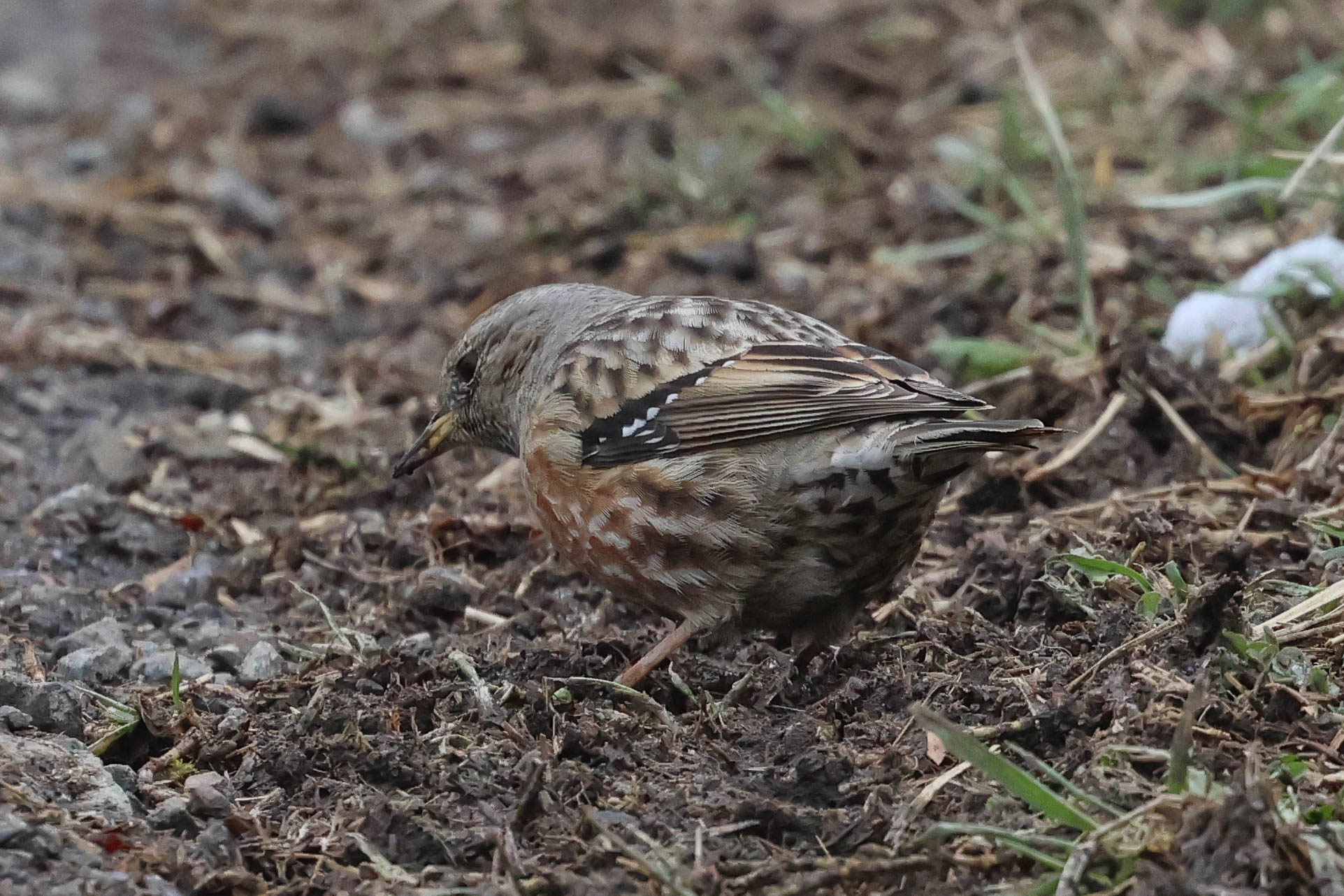
As we got higher, there was a thicker covering of snow again and fewer birds and over the coll at the top, we started to descend again through thicker forest, where we stopped and had a walk along the road. We were hoping for woodpeckers, but the branches of the trees were still covered in snow and they were silent. We found a couple of tit flocks, groups of Long-tailed Tits, with Nuthatches, several Marsh Tits and Coal Tits, a Eurasian Treecreeper. Our third Lammergeier of the morning flew over the trees. It was time for lunch, so we drove back up to the top of the coll where the sun was now shining. A couple of Griffon Vultures drifted high over the ridge beyond.
We dropped back down the other side and had a drive round the fields in the villages lower down. Again, there were lots of thrushes and Robins, plus a few small flocks of Chaffinches and three Rock Buntings. We stopped on the bridge over the river back by the main road, where a Grey Wagtail was feeding around the rocks below and then a (White-throated) Dipper appeared from the water. We disembarked and followed it downstream, but it disappeared into a culvert under the road, presumably where it was nesting. We then realised there were two Dippers here, a pair, but they were very flighty and kept disappearing off either up or downstream. Back on the main road, we stopped again in a village and walked down to the river, flushing a Grey Heron from right next to where we had parked. There were two more Dippers on this stretch, but they too kept disappearing off along the river ahead of us. A Short-toed Treecreeper was in the trees here too.

It was a long drive back from here, so we set off back through the tunnel into Spain and then down the other side. It was sunny here too now, but there was still a bitter wind blowing off the tops and down the pass on this side – we had been luckier with the weather in France today. Back at our base, after a break to freshen up and then do the bird log for the day, we had another delicious home-cooked local supper of soup with pasta followed by meatballs.
WEDNESDAY 1ST MARCH
Despite having to pack, we made an earlier start this morning and left our base at Arbanies to head down to the steppes south of Zaragoza. It was another cold start, the minibus reading -5C shortly after we set off, and very windy again as we got out of the lee of the Pyrenees. The journey itself was fairly uneventful and after a little over an hour we found ourselves at an area of scrubby steppe just outside Belchite. This is a very good area for Dupont’s Lark, but it was very quiet early this morning – in fact, next to no larks were active as we drove along the tracks, although we did eventually manage to dig out a couple of Thekla’s Larks and a Mediterranean Short-toed Lark (formerly known as Lesser Short-toed). We turned to make our way back to the road, and a Black Kite drifted over, our first of the trip.
We drove into Belchite and stopped at the filling station to use the facilities, then made our way down to the reserve at El Planeron. The air had warmed up a bit now and it was immediately more promising – Calandra Lark and Mediterranean Short-toed Lark were now singing and listening carefully, we picked up the slightly discordant notes of a Dupont’s Lark singing in the distance too.
We were just scanning for that, when another Dupont’s Lark appeared close to the track on the other side of the minibus. It disappeared into the grass, where we could see it creeping through the vegetation and then realised there were actually two Dupont’s Larks there. We drove on a short way to turn the minibus round, so those on the other side could get a better view. The pair of Dupont’s Larks had now worked their way further back. The male perched on the top of a small bush briefly, then the two of them appeared in a small clearing. They were sufficiently far away now that we could get out carefully and get the scope on one of them.

The Dupont’s Larks eventually disappeared back into deeper cover. A Calandra Lark was perched in full view singing further out on the steppe and then two flew round in front of us, showing off their black underwings with broad white trailing edge. After such unexpectedly quick success with the Dupont’s Lark, given the somewhat unfavourable weather conditions, we decided to move on and try for something else.
We drove over to Bujaraloz, getting better views of Red-billed Chough en route, and headed out into the fields to look for Great Bustard. It was already after midday now and there was no sign of the bustards where they had been favouring recently. Driving down one of the side tracks, we flushed a couple of Black-bellied Sandgrouse from a weedy field – they landed again briefly a bit further back, before flying again and dropping down out of view. There was a large flock of Calandra Larks in the same field.
A little further on, at another traditionally good field for sandgrouse, we flushed another two Black-bellied Sandgrouse as we drove up. We stopped here for lunch, by a small pool which had largely dried out, where a Green Sandpiper was feeding in the mud in the bottom. It seemed slightly incongruous to see a Fieldfare fly out of here too, while a small flock of Greenfinches and a larger one of Linnets came in to drink.
After lunch, we drove back to the main road and over to a different area to try there. A huge weedy field held lots of Lapwings and small flocks of Spotless Starlings. We had just said how it looked a good place for sandgrouse when we came across a small group of Black-bellied Sandgrouse by the track. They quickly took off, eight of them, and then we noticed four Pin-tailed Sandgrouse still on the ground straight out from us. We had a good view of them from the minibus before they slowly crept back into the vegetation.
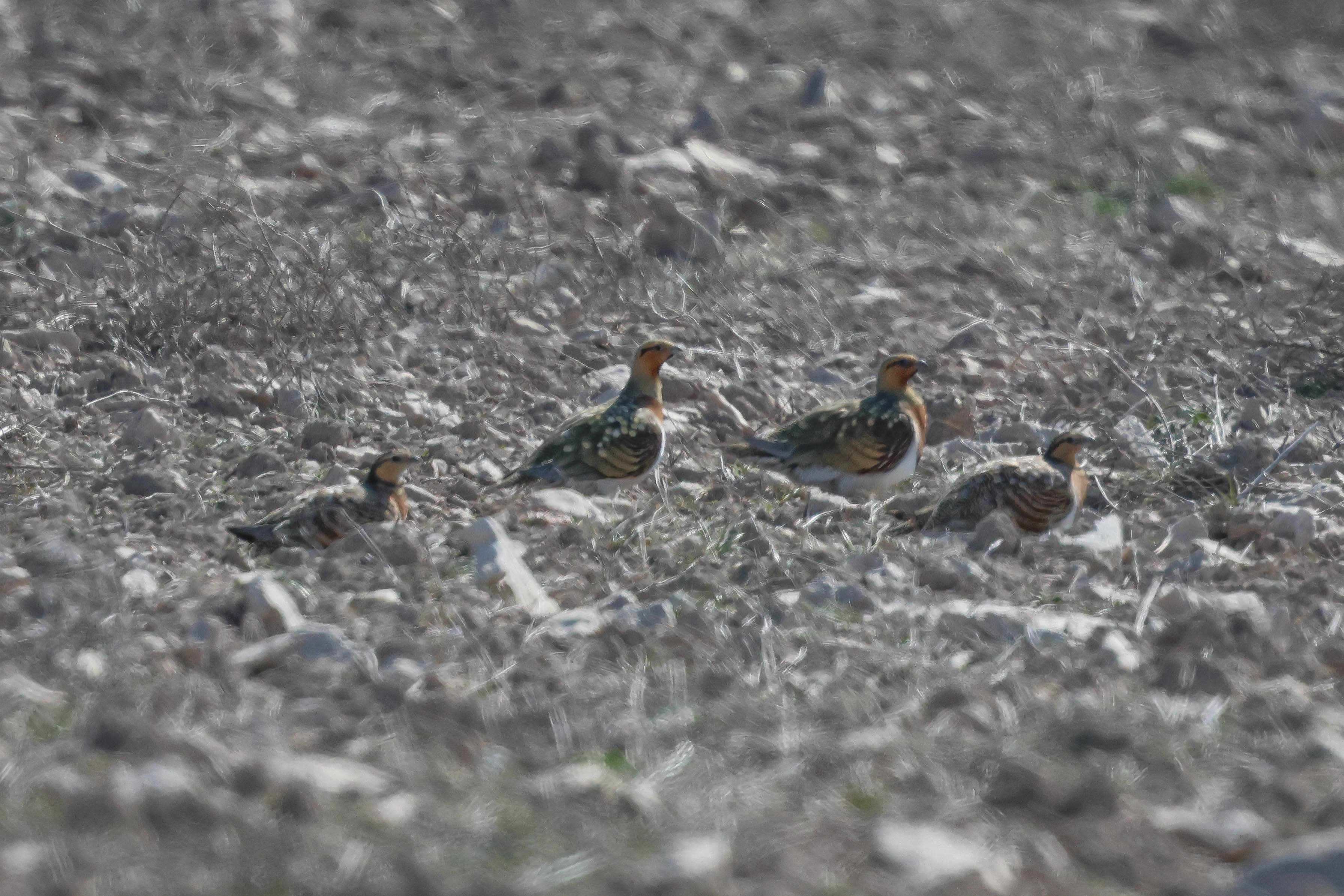
Looping round, a Golden Eagle was being mobbed by two Ravens over the track ahead of us. We decided to head back into Bujaraloz for a break for coffee at the most fantastic truck stop café where the array of boccadillos and selection of fresh tapas and cakes eclipsed the fare on offer at most British roadside restaurants.
After our break, we headed out to have another go in a different area. Driving down another track, an Iberian Grey Shrike was feeding from a roadside at a junction ahead of us but was very jumpy and flew off over the field behind us before we could try to approach. We pulled up to check another field and one of the group noticed a Stone Curlew in the bare field behind us, which walked slowly away. It was sad to see another vast area being cultivated – it had obviously been ploughed some time before but had been left for some time and was overgrown and weedy before the machinery moved in. There were lots of commoner birds around the fields, larks, White Wagtails and Meadow Pipits, Linnets, Goldfinches and Serins, but we couldn’t find the bustards anywhere this afternoon.
As we made our way back to the main road, a male Hen Harrier disappeared away from us over the fields. We decided to meander our way back towards Belchite on the minor roads, to see what we could find on the way. We hadn’t got far from Bujaraloz when we stopped for a Peregrine overhead and another male Hen Harrier flew past. Then just a little further on, a Little Bustard flew over the road ahead of us and landed in the field the other side. A very rare bird in this area now, we found somewhere to stop but unfortunately something spooked it and it flew off before we could get out. A flock of about a dozen Pin-tailed Sandgrouse had been put up too and a Black-bellied Sandgrouse flew round calling.
After that, the drive back was mostly uneventful but as we got closer to Belchite we passed through an area which had traditionally been very good for sandgrouse and larks. We were very disappointed to find that almost all the fields have been cultivated this year, most with either young wheat or bare earth, and very few left to get weedy. A group of Red-legged Partridges were happy enough feeding out in a bare field but there were a couple of fields with some stubble left and pulling up at the first, a pair of Black-bellied Sandgrouse flew out. As we approached the second, a Little Owl was staring angrily at us from a pile of rocks. There were a couple more Red-legged Partridge in here and a pair of Pin-tailed Sandgrouse, which we just managed to get in the scope before they crept back out of view over a low ridge.
It had been a long day and the sun was starting to drop and it was getting colder again, so we made our way over to our accommodation for the night in Lecera. Unfortunately the local café has closed down since last year, but the hotel owners had opened a small dining area in a barn on site, with a woodburner and roaring fire to cook on and served us another wonderful meal of soup or spaghetti, followed by chargrilled chicken or sausages or rabbit stew.
THURSDAY 2ND MARCH
Our last day, but we didn’t have to be back at the airport in Barcelona until late afternoon so we would be able to make the most of the day. After a delicious last breakfast of tortilla, jamon and cheese, and croissants with homemade membrillo and apricot jam, we set off back to El Planeron. It was still in Lécera but much windier out on the plains, still quite cold, and quiet at first as drove in along the tracks.
We quickly located the same pair of Dupont’s Larks we had seen yesterday, but they were a little more distant and keeping mostly to the denser cover. We were really hoping to hear a bit more song this morning, but very little was singing. A Golden Eagle dropped down onto the ground off in the distance. We decided to try another track, to see if there was any more activity there, but it was even more exposed here. We did have great views of a pair of Mediterranean Short-toed Larks on the ground right by the track, the male singing. A few more Calandra Larks were starting to sing too now, so we turned around and went back to the pair of Dupont’s Larks. The male was just starting to sing now, which was great to hear, but they were still not showing as well as they had done yesterday.
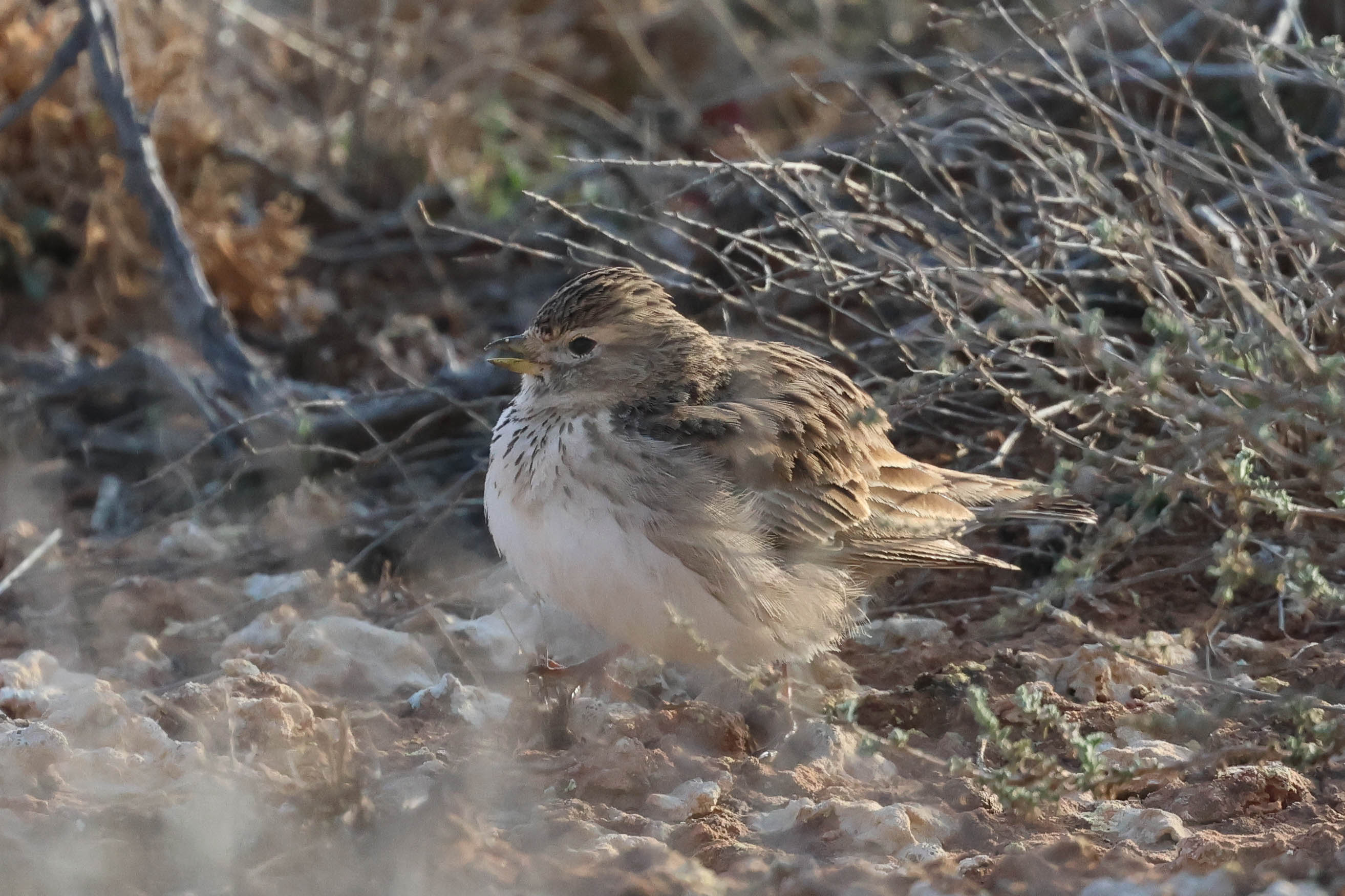
As we drove back towards the main road, we stopped briefly to look at the small wetland in the reserve. Several Marsh Harriers were hanging in the air and a few Lapwings were scattered around the edge. Two Black-bellied Sandgrouse landed briefly over the far side, then flew up again and dropped down into the fields near the exit track. We could see them still over that side as we drove out, but they were very jumpy and took off as soon as we pulled up.
We had a bit of time to play with, so we decided to have another quick look at the plains south of Bujaraloz, to see if we could locate any Great Bustards. We drove round some of the favoured fields but there was no sign at first, until we spotted one in flight way off in the distance. We watched it fly across and eventually it dropped down into a stubble field, so we raced on down the tracks to see if we could catch it there. Unfortunately when we got there it had disappeared – the field didn’t look particularly attractive for one, so presumably it had taken off again. We checked the tracks over the hillside beyond but there was no further sign of it. Frustrating!
There were a few Thekla’s Larks around the scrubby slopes. As we drove back down, we stopped to look at seven Black-bellied Sandgrouse in a wheat field which unusually stayed where they were, allowing us some nice views. We had several more things we wanted to try to see on our way back still, so we had to call time and move on. As we set off, we had three Golden Eagles over the road just east of town.
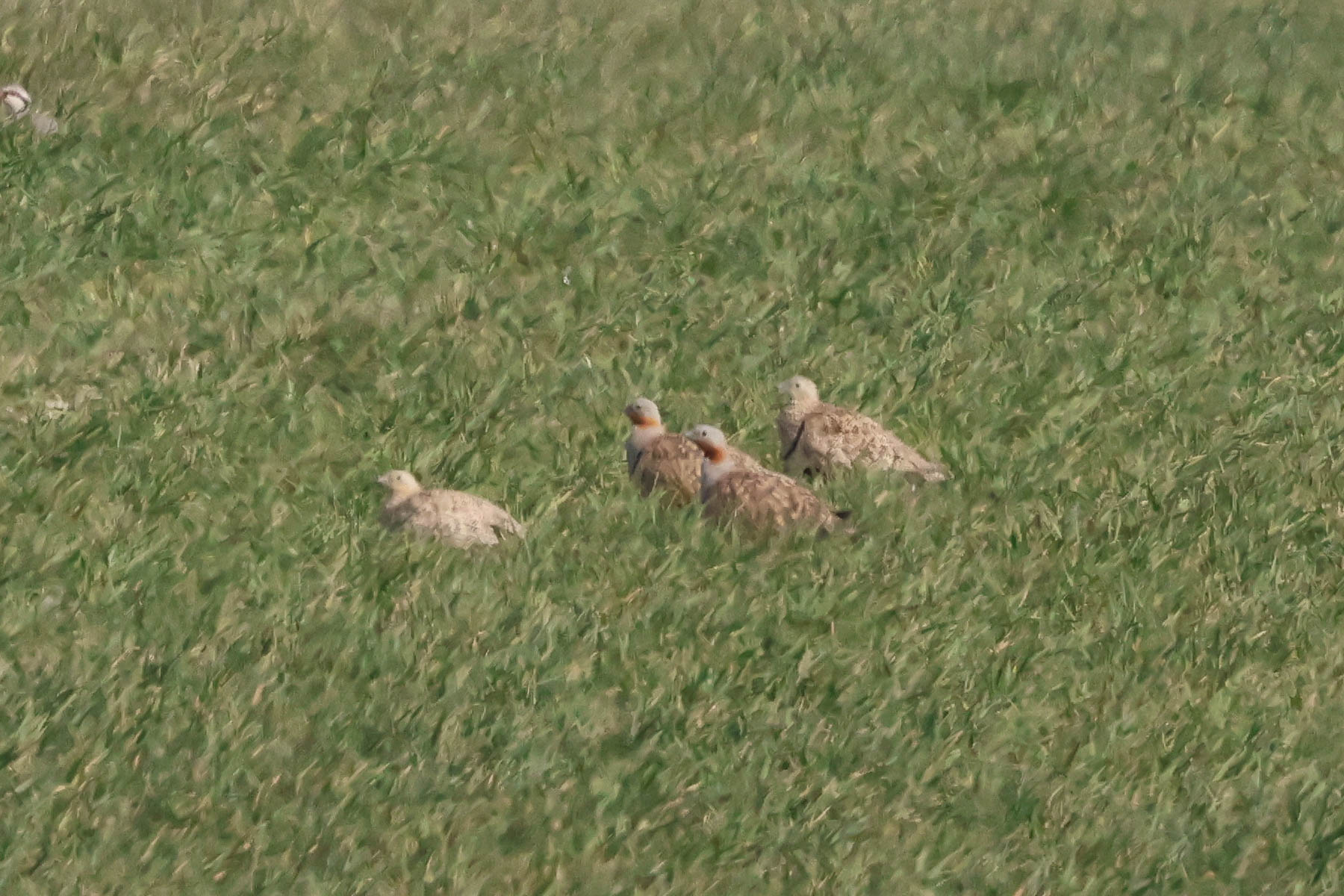
We stopped for lunch at a small lagoon near Candasnos. As we drove down towards the viewpoint, two Hoopoes flew up from the garden of a small house, one landing in a nearby pine tree. Three Red-crested Pochard, two Common Pochard and a lone drake Pintail, all additions to the trip list, were out on the water with lots of Teal and Mallard. Round the margins were a few Coot, Moorhen and Little Grebes and a few Great White Egrets and Grey Herons were loafing on the edge of the reeds. Several Chiffchaffs were flycatching from the vegetation, there were several Reed Buntings in the reeds and a couple of Cetti’s Warblers shouted at each other.
Our next target was Eagle Owl and closer to Lleida we drove down to a small rocky gorge on the edge of a village. We set the scopes up and the female Eagle Owl was staring back at us from a cleft in the rocks on the other side of the gorge. She gradually settled back down onto her eggs and we could just see the top of her head and her huge ear tufts. A male Blue Rock Thrush was on the roof of one of the buildings nearby. As we set off again, another Hoopoe flew ahead of us along the road and landed in the bushes on the verge.
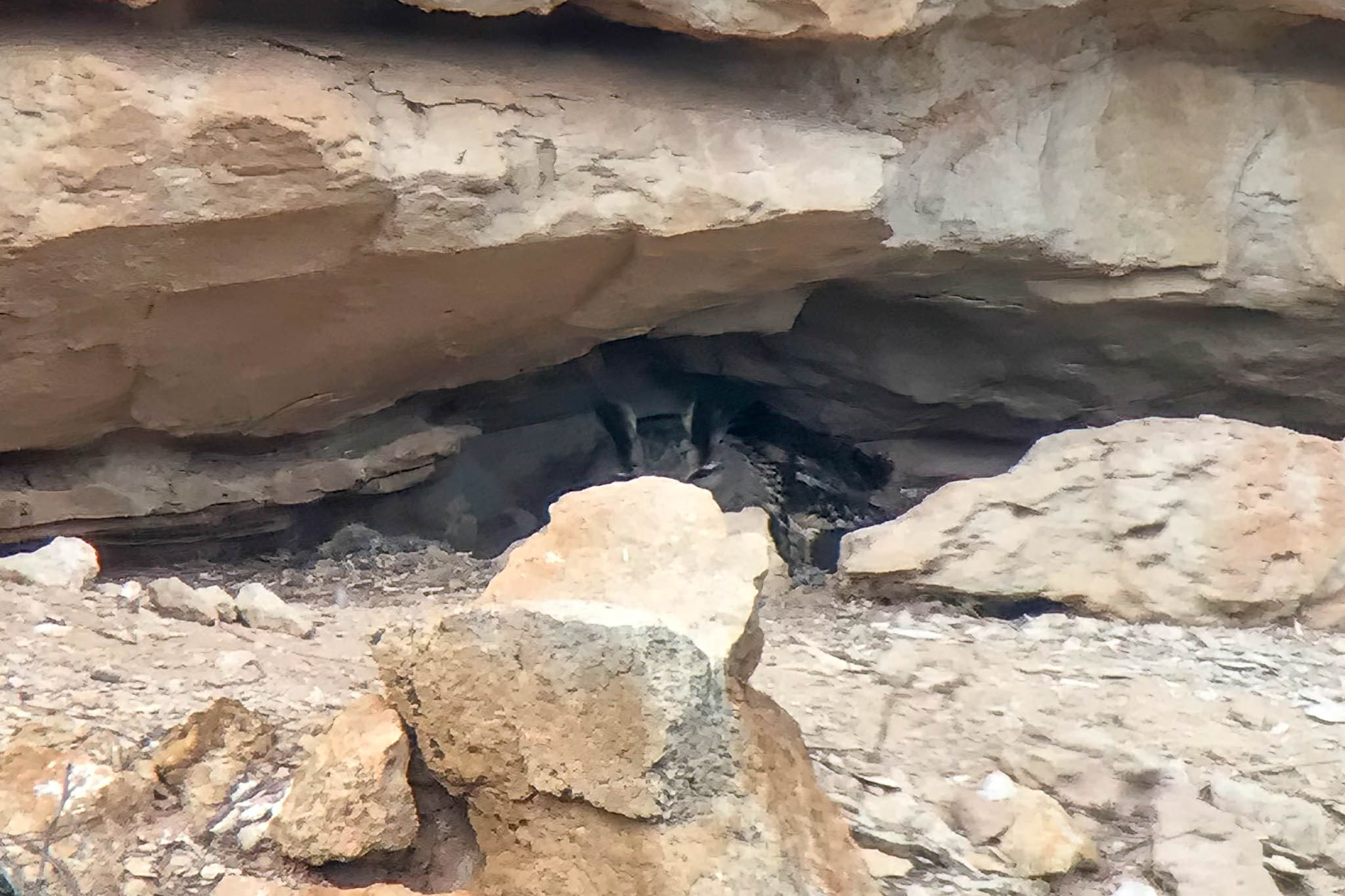
We drove on to a good area for Little Bustards and as we drove in along one of the tracks, we stopped to scan the fields. We could just see a few heads showing from a low wheat crop at first, then a few more heads appeared, but still only around a dozen birds. We drove a bit further on, where we could get out of the minibus behind a large evergreen tree and set up the scopes. We could just see a few heads from here still, but then something spooked them. Amazingly, a flock of 90 Little Bustards came up, followed by another 17 and whirled round overhead before dropping back down further back. There were still at least 5 Little Bustards in the wheat, so well over 100 birds in total here, a very impressive flock, given how rapidly they are declining in many places now.

We had to make our way back to Barcelona now, but we made good time on the journey and arrived with about half an hour to play with before we had to be at the airport. Time for one last stop, we drove to the beach just beyond the terminals. There are often Audouin’s Gulls here, but unusually there was no sign of any this afternoon – there were just a few Yellow-legged Gulls and a lone Black-headed Gull flew over. Several Gannets were flying round or plunge-diving offshore and four Shoveler flew past out over the sea. A Cirl Bunting flew up from the grass behind the beach.
Then it was over to the car rental return to drop off the minibus and time to check in. Our flight left on time and arrived at Gatwick over 15 minutes early, and when our bags arrived unusually quickly too it was only just after the time we were originally due to land. It is always nice when that happens, especially given it was late now. Then it was time to say our goodbyes and head off our respective ways.
















